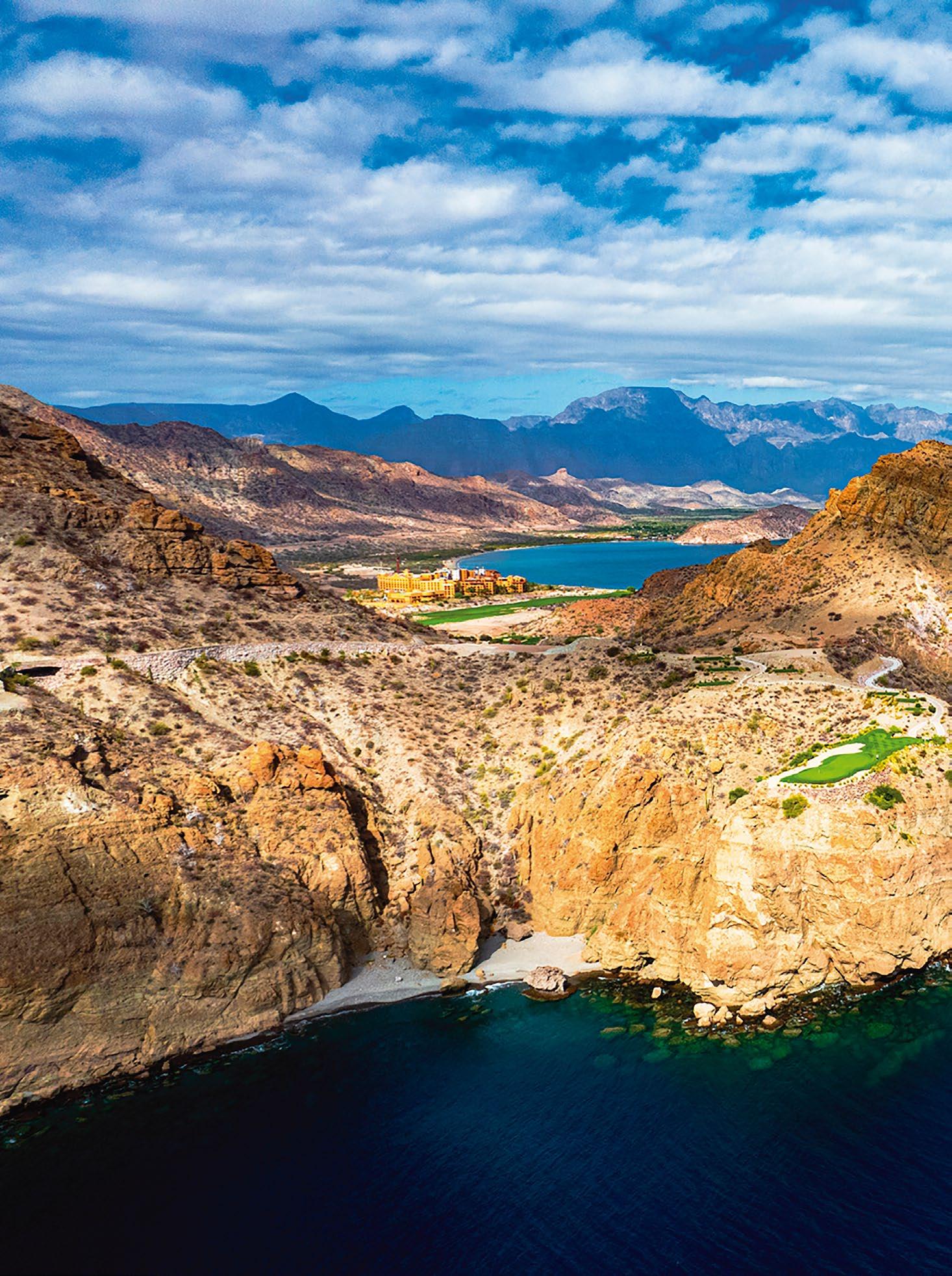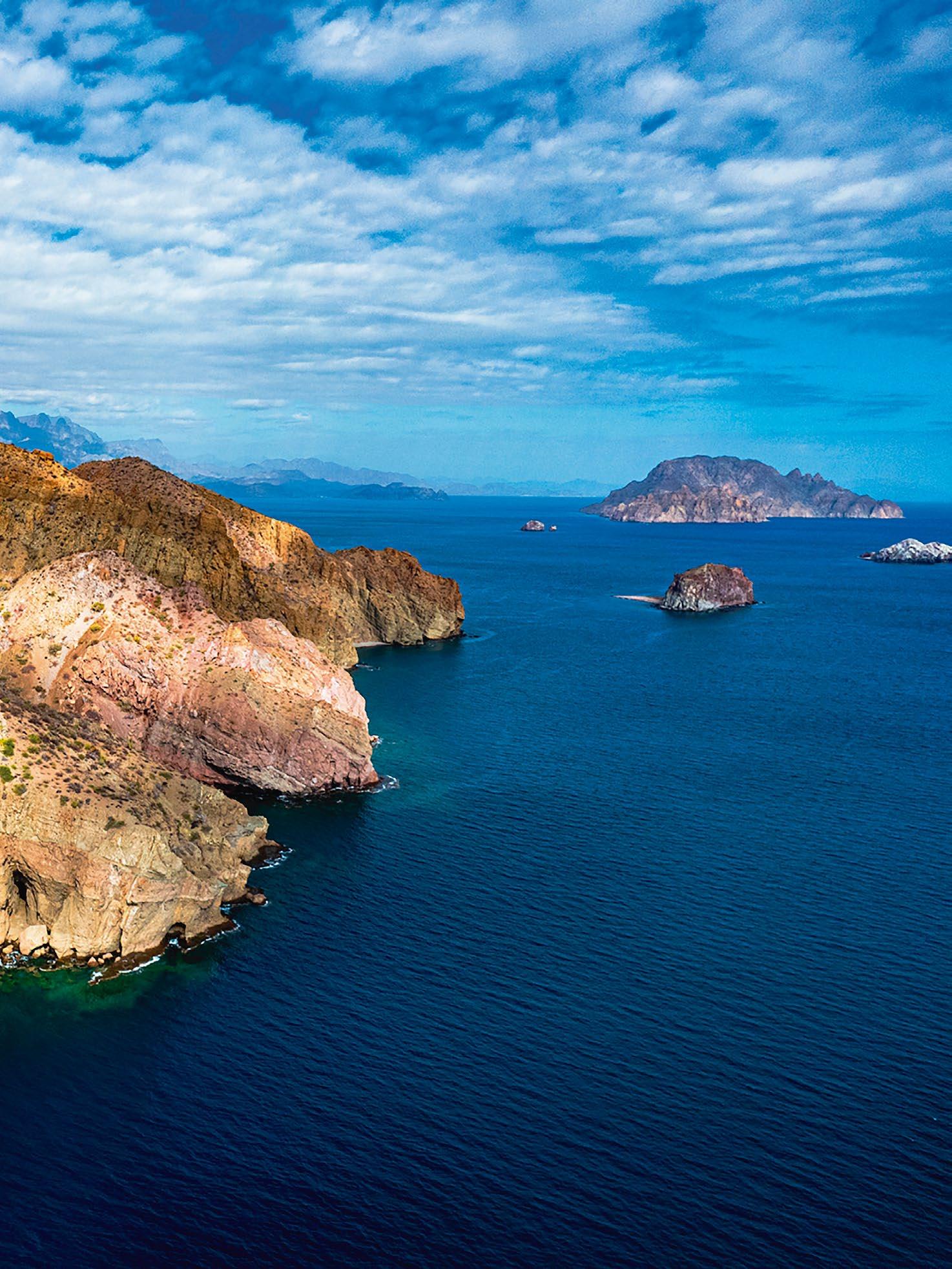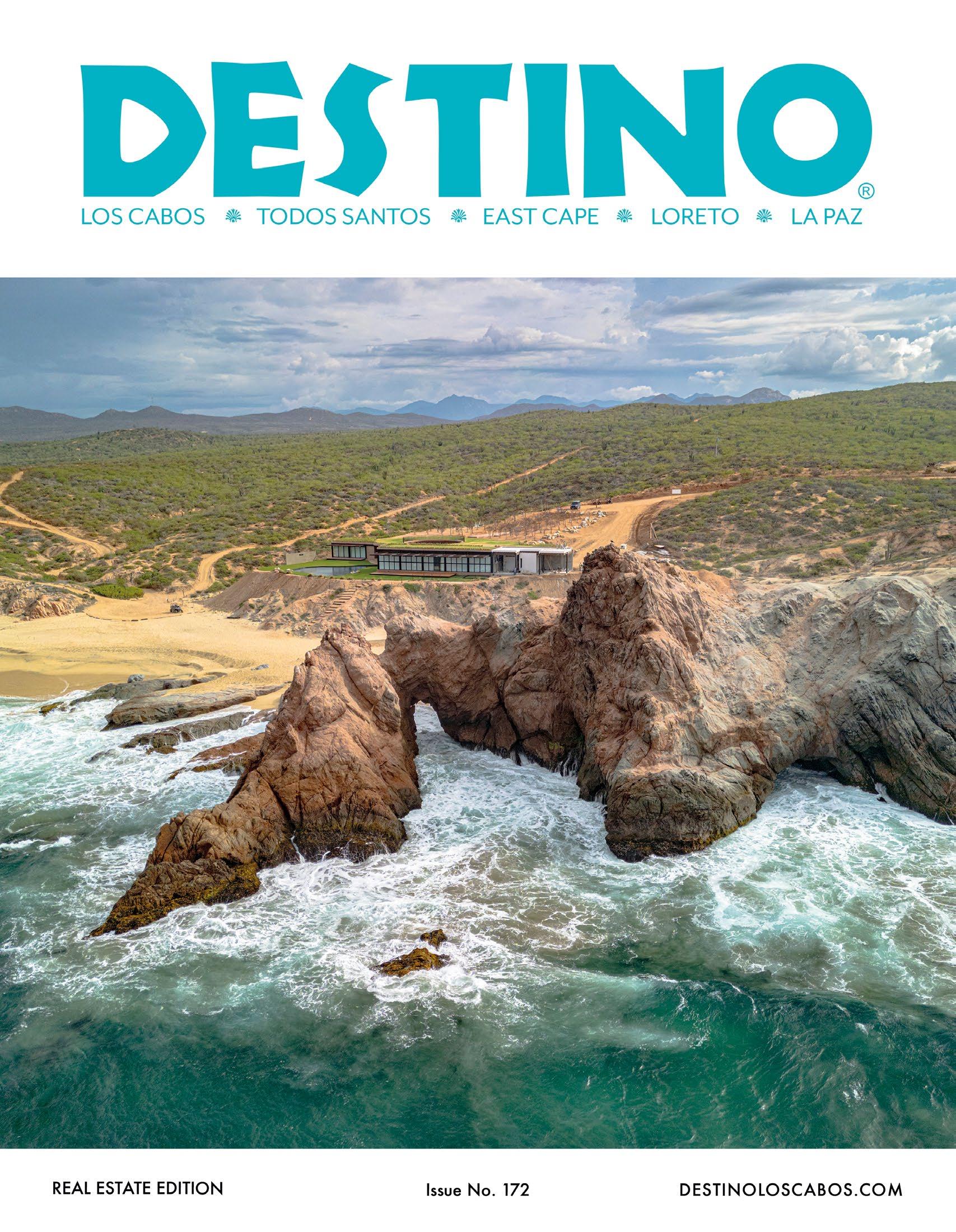






Fall is a season of transition, and in Baja California Sur, the changes are clear in the real estate market, in our communities, and in the ways people imagine life here.
For this edition, we chose real estate as our central theme. It is a timely subject, especially in these months when the season begins to turn and decisions about building, investing, and settling take shape. We approach it from the Destino point of view: not only as a market, but as a way of understanding how people live and what kind of place Baja is becoming.
We examine the transition from speculation to strategy in Los Cabos, the frontier energy of Cerritos, and the steady, quiet rise of Loreto as a boutique destination. We also consider how golf and wellness are shaping residential life, and what it really means to build well in this landscape.
At the same time, this issue highlights other dimensions of Baja California Sur. We feature a photo essay on vernacular architecture, celebrate the work of local photographers, and share our seasonal guide to restaurants, events, and things to do across the peninsula's meridional end.
Destino itself is evolving, too. A new format, more pages, richer images, and sharper editorial all point to a single aim: to create a magazine worth keeping, not just for the season but as part of the story of South Baja.
Welcome to the Fall 2025 edition, Alejandro Ehrenberg
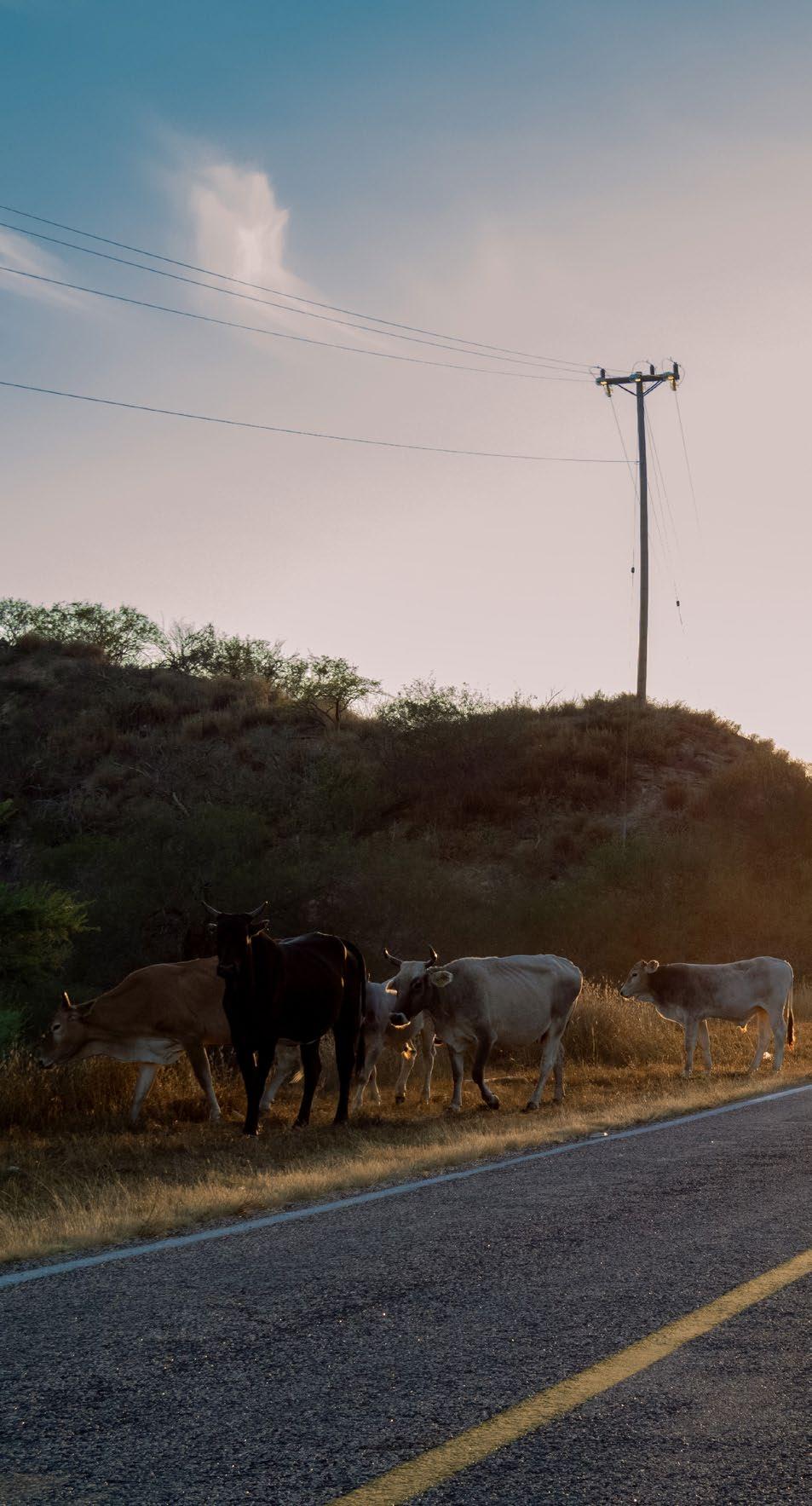
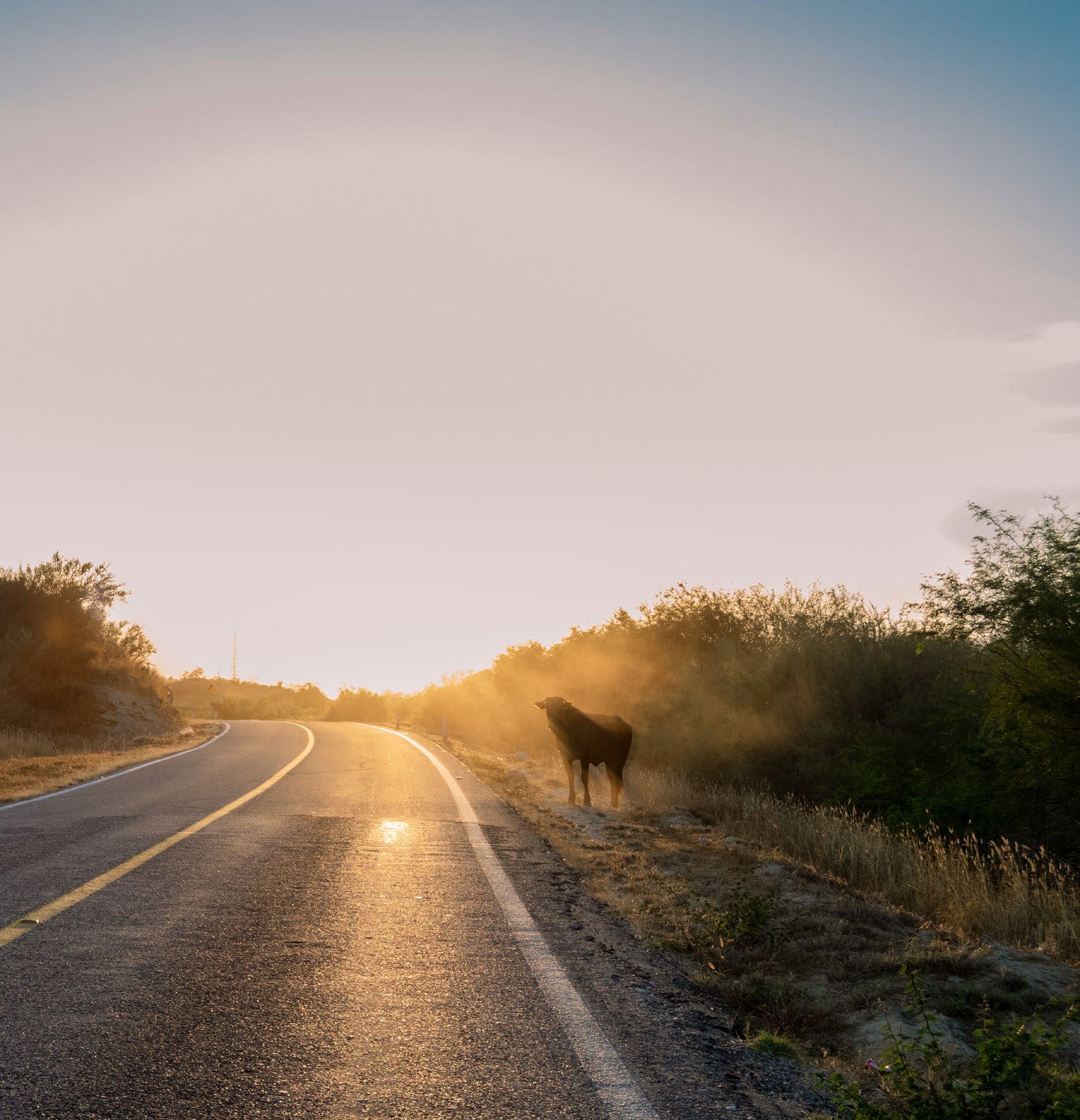
PUBLISHER
Owen Perry
EDITOR IN CHIEF
Alejandro Ehrenberg INVESTMENT MANAGER
Lance Niederhaus
GRAPHIC DESIGNER
Rebeca Beltran CONTRIBUTORS
Barrie Livingstone
Victor Suarez
DIGITAL TEAM
Erika Coatzin – Social Media Manager
Victor Suarez – Content Strategist
WEBMASTER
Edgar Valdez DISTRIBUTION
Christian Jiménez
SALES EXECUTIVES:
Christian Jimenez
Yoselin Hideroa
EDITOR’S CONTACT: alejandro@destinoloscabos.com
COVER PHOTO:
Cabo San Lucas’s “Second Arch,” located in Rancho San Cristobal
Photo: Raymundo García Herrera
Instagram: @rayincabo

Follow us: @destinomagazine
DESTINOLOSCABOS.COM
Sierra de la Laguna, San Dionisio
Photo: Alejandro Méndez Martínez de Escobar Instagram: @alex.fpv2

INTERESTED IN ADVERTISING?
+52 (624) 105-9700 Contact us:
DESTINO GROUP SA de CV Tél: (624) 105-9700/ (624)142-4949 / Dirección: Carretera Federal Libre Transpeninsular San José San Lucas. Km. 4.3, Local 6, Col. El Tezal, Cabo San Lucas, Baja California Sur / Email: contact@destinoloscabos.com / © 2021 Destino Group SA de CV / / NÚMERO 172 OTOÑO 2025 Todos los derechos reservados por Destino Group. / Prohibida la reprodución total ó parcial del contenido sin previa autorización por escrito de los editores. ISSUE 172 FALL 2025 Printed in Mexico. All rights reserved. No part of this publication may be reproduced in any form without the written consent of the publisher. DESTINO GROUP welcomes all written and photographic material. We cannot guarantee return. Rights to publish unsolicited material are retained for 12 months. Circulation throughout Southern Baja. For more information on distribution visit: DESTINOLOSCABOS.COM
The best events, activities, and restaurants to enjoy across the southern end of the peninsula this season.
Destino Awards
Three standout restaurants inside private residential communities in Los Cabos — open to all.
From Speculation to Strategy: Los Cabos Real Estate Today
Why investors are shifting from quick flips to long-term positioning in a maturing market.
Why Cerritos Is the Next Big Thing in Baja Real Estate
This once sleepy surf break is attracting boutique developers and luxury second-home buyers.
Loreto Rising: From Quiet Outpost to Baja’s Boutique Luxury Destination
How a historic seventeenth-century town is positioning itself as a select, high-end market
From the Ground Up: Three Expert Voices on Building in Baja
Insights from an architect, designer, and builder on navigating the realities of construction in Baja California Sur.
Baja California Sur’s vernacular architecture and the knowledge that shaped a land.
Cabo’s Long Game: How Diamante and the PGA Tour Redefined Golf Real Estate
An inside look at how the sport has influenced Cabo’s high-end property market.
Why Private Developments Are Investing in Healthcare, Education, and Community Services in Los Cabos
How master-planned residential enclaves are using their foundations to bring essential services to the community.
On the Pulse
Barrie Livingstone’s take on what’s shaping life in Baja right now.
When Living Well Means Living Longer: Why Regenerative Medicine Is Entering the Real Estate Conversation
The rise of wellness-driven property offerings is driven by high-net-worth buyers seeking longevity-focused lifestyles.
Exceptional Residences Across Baja California Sur.
A curated look at properties that exemplify design, location, and lifestyle value.
LOS CABOS
Cocina de Autor – The Corridor
Located inside Grand Velas Los Cabos, Cocina de Autor is the region's only Michelin-starred restaurant. Chefs Sidney Schutte and Francisco Sixtos craft a seasonal tasting menu where Baja ingredients meet global technique. Examples include beurre carrot noisette; wagyu with fig and tartufata; a shiitake-stuffed tetela in corn velouté. The experience pairs with wines like Trento Blanc de Blancs or Valle de Guadalupe blends. Formal but comfortable.
Acre – San Jose del Cabo
Acre is part farm, part restaurant, part jungle escape. Its award-winning bar sets the tone with torch-lit cocktails infused with hibiscus, guava leaf, and dried citrus, served under the stars. The menu draws heavily from Acre's fields: tuna crudo with mango leche de tigre, heirloom tomato salad with goat cheese and a red wine vinaigrette, kampachi linguini with Acre pesto. Sophisticated yet unpretentious, it's designed for lingering.
Café des Artistes – San Jose del Cabo
Chef Thierry Blouet's flagship delivers French-Mexican elegance in a polished, art-filled room. The multi-course tasting menus offer precision without theatrics; the à la carte fare includes standout dishes like short rib and charcoal beef fillet, morels with fresh truffle ravioli, and a rotating dessert menu rooted in craftmanship. Elegant, intentional, and never fussy.
Invita – Cabo San Lucas
Invita delivers confident Italian cooking in a laid-back downtown setting. Standouts include chicken piccata, housemade gnocchi Bolognese, and squid-ink pasta with crab. The antipasti selection is strong, and the wine list leans

local, with bottles like Bruma Bianco from Valle de Guadalupe offered alongside classic Italian pairings. Service is polished and personal, often remembered by name. A reliable pick when you're ready for a shift from tacos and tequila.
TODOS SANTOS / PESCADERO / CERRITOS
Oystera – Todos Santos
Set inside a restored sugar mill market, Oystera pairs architectural aesthetic with serious seaside flavor. The menu leans shellfish-forward: oysters on ice with xoconostle mignonette, grilled scallops, shrimp with guajillo butter. Light filters through brick arches; the mezcal list is worth lingering over. The menu is seasonal and changes depending on the ingredients available in the region.
Tenoch – Todos Santos
Nestled within Paradero Hotel, Tenoch turns regional ingredients into bold statements. Its signature soft shell crab taco comes crowned with basil guacamole and red cabbage salad. Other standouts include grilled chocolata clams, octopus tacos, and green apple aguachile with scallops and veal gizzard. Stylish without contrivance.
Hierbabuena – Pescadero
An enduring favorite for gardento-table cooking in an open-air citrus grove. Flatbreads with fig, goat cheese, and arugula showcase ingredients at their peak. You dine amid herbs and fruit trees, with wood-smoked aromas and relaxed service that feels intensely local.
Baja Beans Coffee – Pescadero
More than coffee, it's the weekend pulse of Pescadero. On-site roasting fuels community gatherings: quiches, cinnamon rolls, street vendors, musicians, expats in widebrim hats. The coffee is solid, the
vibe is relaxed, and it's the perfect stop anytime.
EAST CAPE: LA VENTANA / EL SARGENTO / LA RIBERA / LA FORTUNA
Zai Sushi Surf Bar – La Fortuna
Open-air and casual by design, Zai combines surf-town energy with serious Japanese technique. Yellowtail sashimi with serrano and soy is a favorite; rolls are vibrant but never overdone. Great for post-surf swinging reactions or calm sunset finishes.
Pizza Gourmet San Antonio –El Sargento / La Ventana
A surprising standout in El Sargento. Hand-stretched thin crusts, glutenfree and vegan cheese options, and combos like hot honey with spinach or arugula (vegan) earn consistent praise. Friendly staff, dog-friendly energy, and solid value make it a regular stop for surf travelers and locals alike.
Delphine at Costa Palmas –La Ribera
Ludo Lefebvre brings Riviera polish to a quiet corner of the East Cape. Think light, vegetable-forward plates: fried calamari, lamb chops Provençal, grilled ratatouille. Steps from the water, with thoughtful service and wine pairings that feel intentional, not showy.
LA PAZ NEMI
Tight, 20-seat dining that lives at the intersection of ambitious and personal. The weekly tasting menu features local ingredients in dishes like roasted beet salad with hibiscus and granola, wagyu cheek, and lobster rice. The passion fruit mezcal cocktail is a favorite. Reservations essential. Menu changes with the seasons.
Quemadero
This smokehouse operates with a focus on grilled Angus rib-eye, open-fire fish, and rotating craft beers. The communal tables and mismatched bowls evoke Baja authenticity. Turn up for flavor, not fuss, and expect good company.
Oyster House by FISM
Neighborhood raw bar with a frontrow porch seat to La Paz streets. The San Buto oysters and morita aguachile lead the menu. Still, the Sandwich FISM — fried oysters with Parmesan and tartar sauce— is equally compelling. Small, airconditioned interior; porch seating is the draw. Casual, fun, memorable.
Behind a downtown parking lot lies a shaded courtyard with a lived-in local spirit. The menu blends Sonoran cuts with coastal flair: lobster mac & cheese, truffled chocolata clams, and the Taco Llanero — rib-eye with cheese crust and bone marrow — stand out. Textural, grounded, quietly refined.
Oceanfront calm meets culinary ambition. Chipotle and mezcal shrimp, grilled octopus with zarandeado sauce, and a wine list leaning toward Valle de Guadalupe. Relaxed service, unforgettable views, best experienced at sunset.
A downtown Loreto institution that consistently delivers. Grilled catch of the day, seafood risotto, seasonal soups, all executed with polish. The terrace seating is ideal for dinner under the stars, and the staff quickly becomes familiar with repeat visitors.
Hike Sierra de la Laguna
Fall is the window. Summer's heat breaks, and the mountains still carry the green of the rainy season. Trails begin in dry scrub and climb into pine and oak. With a guide, you can reach waterfalls tucked into canyons or see wild orchids clinging to granite. Most hikes start before dawn. Worth it for the light alone.
By mid-December, the first humpbacks and grays begin arriving. The primary season is winter, but fall tours catch the early movement without the crowds. Smaller boats mean better positioning: closer to breaches, more time drifting. Book with operators who prioritize distance and respect over spectacle.
Snorkeling and Diving in Cabo Pulmo Cabo Pulmo's protected reef feels almost exaggerated. It's densely packed with fish, hard coral, and sea turtles shadowing the surface. Fall is prime: visibility is at its peak, and the water stays warm. Divers may spot bull sharks or massive groupers. Snorkelers stick closer to shore but still see clouds of snapper and rays gliding underfoot.
Kitesurfing in Los Barriles
By late October, the wind returns and the sails go up. Los Barriles becomes kinetic. Kites tracing arcs over the water, instructors shouting from the sand. Lessons run daily, and the vibe is low-pressure. You'll see pros and first-timers sharing the bay. Even if you stay dry, it's worth watching with a coffee in hand.
Kayaking and Paddleboarding in Balandra Bay
You've seen the photos — turquoise shallows, mushroom rock — but fall is when Balandra feels real again. Fewer crowds, lighter sun, calmer water. Paddle around the mangroves or beach-hop toward Tecolote. Mornings are quietest; you might share the bay with pelicans and not much else.
La Paz handles these well: small groups, certified guides, and clear protocols. The season starts in late October, as the sharks return to feed on plankton blooms. Swimming beside them — slow, striped, nearly silent— is as calm as it is overwhelming.
Afternoon Walks on the Malecon
This isn't an activity, it's a way of life. From October on, locals reclaim the malecon in the late afternoons, walking, skating, stopping for ice cream. The breeze comes in from the west, and the sun drops behind the bay. No itinerary needed.
SANTOS / PESCADERO / CERRITOS
Surfing at Cerritos Beach
Cerritos is the break for beginners and longboarders. Fall brings steady, manageable swell and water warm enough to skip the wetsuit. Local surf schools post up early with soft-tops and shade tents. Even if you don't surf, the scene, with families, couples, and kids tumbling in the whitewash, makes for a good day.
Workshops at the Modern Elder Academy
Part retreat, part classroom, MEA's programs focus on transitions: career shifts, life rethinks, reorientation. The beachfront campus sits just south of Pescadero and draws a global crowd. Some workshops run four days, others a whole week. Expect reflection, but not retreat-style fluff.
Hiking Punta Lobos
The trail starts behind the old cannery and climbs fast. Within minutes, you're above the beach, looking down on fishing pangas and up toward cliffs. The full loop takes under two hours and includes panoramic ocean views, seasonal wildflowers, and the chance to spot whales if you time it right.
Island Tours in Loreto Bay National Park
This is where Baja's wildness feels intact. Boats leave early to reach the uninhabited islands of Coronado, Danzante, and Del Carmen, where you can snorkel in coves, hike desert trails, or watch sea lions basking on volcanic rock. The sea is flat in fall, the sun lower, the horizon sharp. Bring a hat and time to drift.
One of the oldest stone missions in Baja, San Javier sits deep in the Sierra de la Giganta. Getting there is part of the experience: narrow roads, sudden valleys, pockets of date palms. The mission itself is simple and enduring. Go early, walk the orchard, and eat at one of the ranch kitchens serving machaca and handmade tortillas.
Hikes, reefs, surf breaks, and slow afternoons: how fall opens up Baja's outdoors.

October through December, across every region — festivals, rituals, and local rhythms.

Dia de Muertos (Day of the Dead) | November 1–2
Not a performance, but a return. In Baja, Dia de Muertos means altars in plazas, candles in the cemeteries, and families gathering across generations. Expect processions, live music, and marigolds everywhere. In towns like La Paz and Loreto, visitors are welcome as long as they come with respect and without a selfie stick.
Halloween | October 31
More celebration than tradition. In resort towns like Cabo, expect costume parades and themed parties. In smaller communities, kids trick-ortreat along neighborhood streets. It's less about authenticity, more about joining in.
Christmas in Baja | December
The season arrives on December 12, the feast day of Our Lady of Guadaloupe, with lights strung across palm trees and posadas winding through town streets. Most plazas host live music and food stalls in the evenings. Some of the best moments are the quietest: families gathered on benches, a local choir under the church portico, tamales sold from a folding table.
LOS CABOS
San Jose Art Walk | Thursdays, Late October–May
The historic center of San Jose del Cabo shifts into street-festival mode every Thursday night. Galleries open late with new shows, bands play on the corners, and artists talk shop over wine. Skip the tourist shops and start in the back alleys for the more interesting work.
Bisbee's Black & Blue Marlin Tournament | October 20-25
The world's richest fishing tournament, and it shows. Massive payouts, high-end boats, and a weigh-in scene at the marina that draws a real crowd. Even if you're not into fishing, the atmosphere (part party, part spectacle) is worth a walk-through.
Los Cabos International Film Festival | Mid-November
Now one of Mexico's most influential film festivals, Los Cabos blends international premieres with a sharp focus on emerging Mexican cinema. Recent editions have expanded beyond traditional theaters into art spaces like Crania, beachfront venues like El Ganzo, and public plazas in San Jose del Cabo. Expect bold programming across fiction and documentary, from Latin America and beyond, plus post-screening Q&As, open-air events, and industry panels on coproduction and digital distribution.
WWTC PGA Tour at Diamante | November 3-9
Held on Tiger Woods' first completed course, this tournament brings international players to Cabo's desert-meets-ocean terrain. It's one of the rare PGA stops where you can watch pros swing while sipping a mezcal cocktail in the shade.
Local Fishing Tournaments | October–November
Less polished than Cabo's tournaments, and that's the point. These events in places like Los Barriles and Buena Vista are as much about community as competition. Expect family-run teams, open coolers, and kids helping haul gear. Prize money matters, but bragging rights last longer.
La Ventana International Kiteboarding | Late December into January
La Ventana turns into a global kite village as the wind kicks in. Throughout December, expect pop-up competitions, skill clinics, and parties strung along the beach. The wind is consistent (15 to 30 knots) and the scene blends nomadic athletes with curious first-timers and Baja regulars.
LA PAZ
Baja 1000 Off-Road Race Start | November 10-16
La Paz hosts the sendoff for this legendary off-road race. Thousands line the streets as custom-built vehicles roar toward the desert. It's not quiet or elegant, but it's a core part of Baja's cultural calendar. Earplugs recommended.
TODOS SANTOS / PESCADERO / CERRITOS
Festival de Cine de Todos Santos |
Late November to early December Intimate but well-curated. Screenings focus on Latin American and independent films, often held in small venues or even outdoors. There's less red carpet, more conversation. If you're a filmmaker or a fan, it's a good place to talk shop.
GastroVino Food & Wine Festival |
Late November to early December Centered in the historic district of Todos Santos, this multi-day celebration blends regional wines with dishes from top Baja chefs. Expect tastings, pop-up dinners, and a Sunday main event that spills into the streets. More mingling than formal dining—bring good shoes and an appetite.
LORETO
Loreto's Founding Celebrations | October 19–25
A weeklong celebration of Loreto's founding in 1697. Parades, concerts, folkloric dance, and food stalls pack the town square. Unlike larger festivals, this one still feels rooted: neighbors greeting neighbors, families staking out benches, kids dancing in matching shirts.
Fiesta de San Javier | December 1–3
Part pilgrimage, part celebration. Travelers and locals make their way on foot, horseback, or by car to the stone mission in the mountains. It's an intensely local moment. At the plaza, there's music, food, and a sense of shared arrival.
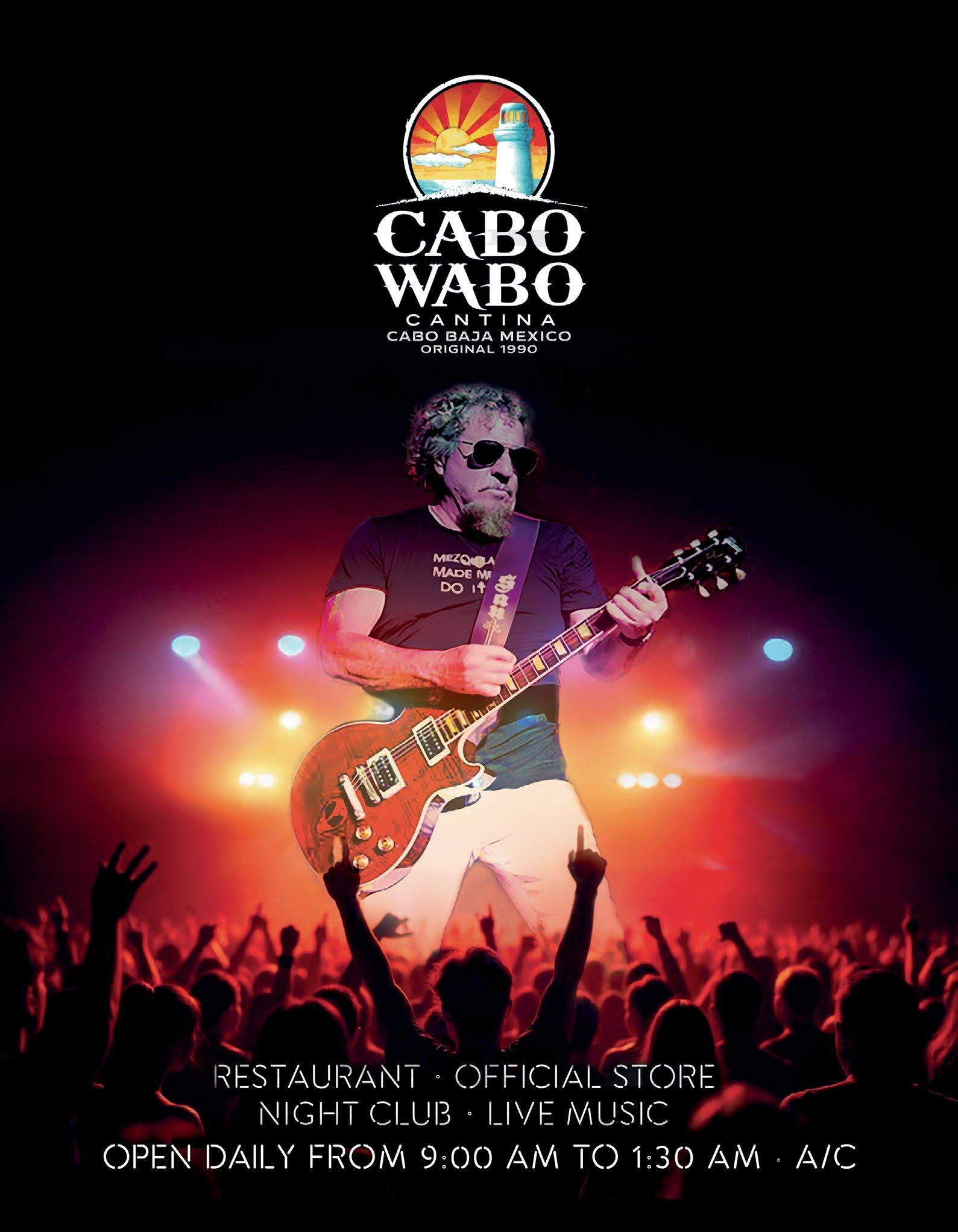
Some of the best dining in Cabo happens inside private communities, places known for golf, gated living, or five-star stays. At Diamante, Chileno Bay, and The Cape, a Thompson Hotel (which also includes The Cape Residences), the restaurants are open to the public and deliver with confidence. Here are three standouts.
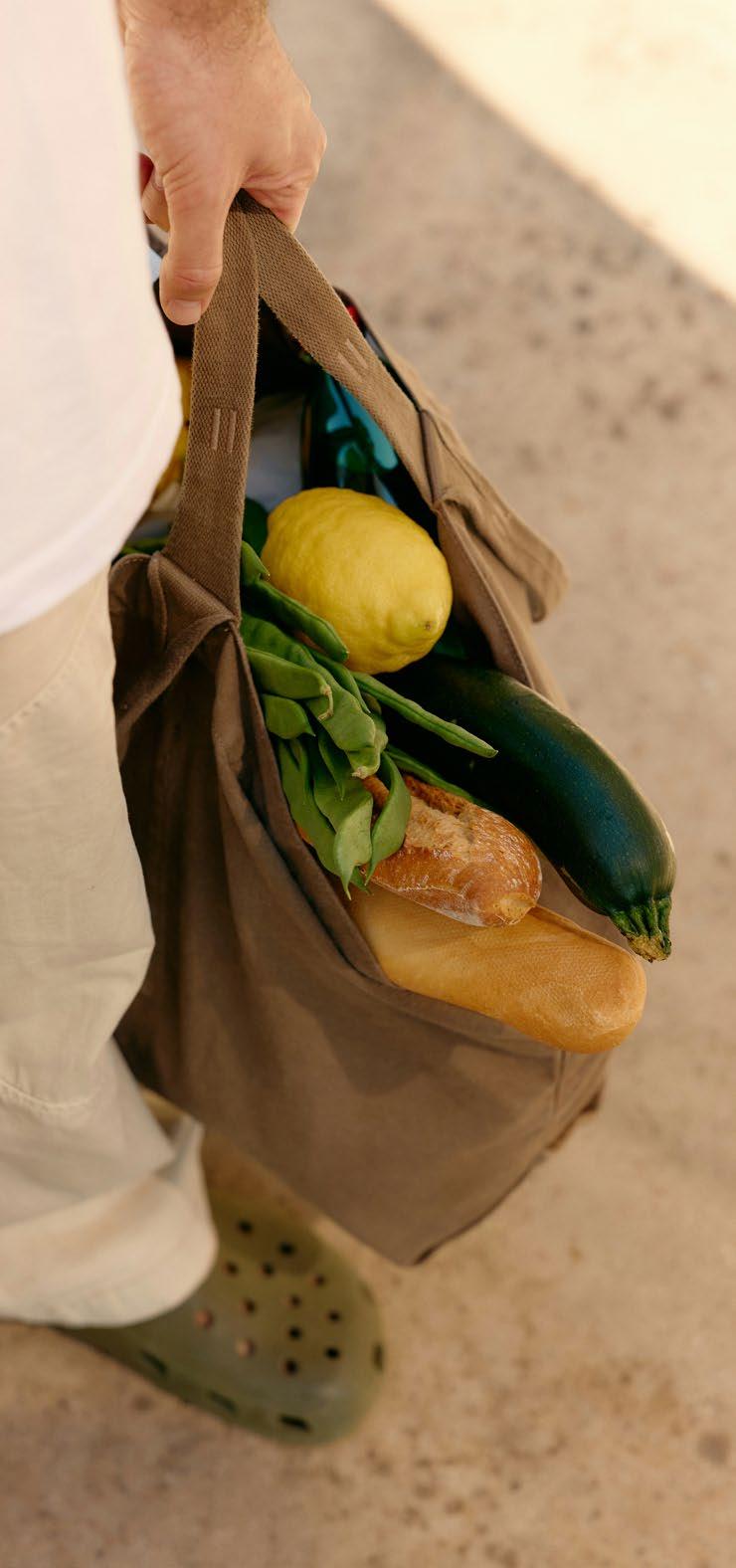
The Woods – Diamante Cabo San Lucas
On the Pacific side of Cabo San Lucas, just beyond the central action hub, The Woods sits within the private golf community of Diamante. It's close to Nobu, Rancho San Lucas, and the Hard Rock Hotel, but a deliberate detour from the usual circuit. The setting is cinematic: rolling dunes, quiet roads, and sunsets that drop straight into the ocean. Under Chef Larbi Dahrouch, the kitchen leads with polish and restraint. The menu is concise and confident. Each dish feels deliberate, from house-sauced nigiris and a beet salad with house-made cheese to a meze-style welcome tray that sets the tone. The standout is the ribeye: Creekstone Farms prime beef, salted and perfectly cooked, with Yukon potatoes and roasted Brussels sprouts. Dessert shifts the tone: a deconstructed lemon pie with meringue and ice cream. Refined, grounded, and quietly assured, The Woods is worth the drive.
– Chileno Bay, The Corridor
Located in the Chileno Bay community, just above the Sea of Cortez, Comal feels both rooted and alive; anchored in Mexican and broader Latin American traditions, yet refreshed with ambition. Under the direction of Chef Yvan Mucharraz, the experience balances precision with warmth. Service sets the tone: relaxed, attentive, and personal. The kitchen walks a fine line between invention and comfort: cacao tortillas with avocado; reyna clam and sea scallop a la diabla with ginger, cucumber, and fermented chilies sauce; short rib "doraditas" with chihuahua cheese. A standout mocktail of bright pineapple, two-toned, not sweet, is followed by a mezcalCBD cocktail. Wines are selected for their stories as much as their flavor. Best of all: a roasted totoaba with parsnip purée, roasted cauliflower, and toasted almonds, and a tres leches with pecans and peaches that lands like a childhood memory.
The Cape, a Thompson Hotel – Cabo San Lucas
More than a hotel, The Cape is a rhythm of spaces: Manta's fine dining, Sunken Bar's raw bar and cocktails, The Ledge's oceanfront comfort, and a rooftop that draws locals for sunset DJ sessions. What connects them is intent. Executive Chef Ari Reyes blends tradition and invention, from a new lobster risotto with huancaína sauce at The Ledge to reimagined Baja classics across the property. Sommelier Cindy Sandoval, recently nominated among Mexico's best, curates wines with story and structure, pairing rare finds with intuitive depth, like a barrel-aged Coahuila Chardonnay to match the risotto's richness. Guests return not just for the views, but because the team remembers what they loved for their next visit. Manta, designed by Enrique Olvera's team, anchors the culinary offering with dishes like ribeye with chile crust and octopus anticucho. At The Cape, precision and warmth live in balance.
Real estate is impossible to ignore in Baja California Sur. As you walk through towns like San Jose or Cabo San Lucas, as well as the more remote communities in the East Cape, you will encounter signs advertising pre-construction condos, gated communities, and ocean-view villas.
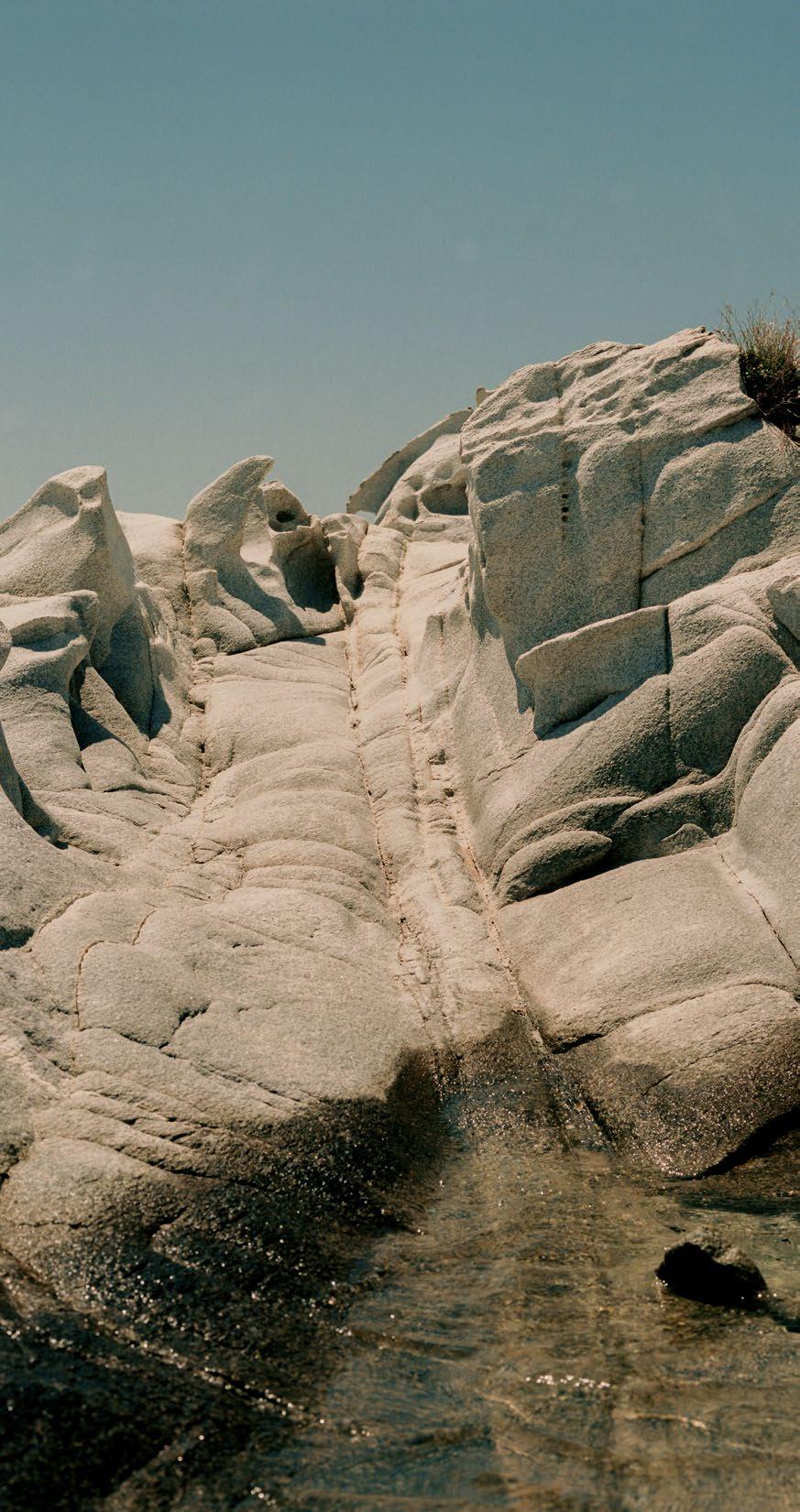
Numerous real estate offices display their listings in their windows. This leads both visitors and locals to wonder: How is the market doing?
The answer is more nuanced than most brochures or headlines suggest. Post-COVID buying trends continue to shift. Prices are up, incentives are changing, and the once-obvious advantages of buying preconstruction aren't as automatic as they used to be.
To make sense of it all, we turned to broker Fletcher Wheaton, someone who's watching the market evolve day by day. His insights cut through the noise and offer a grounded take on what's still worth considering, what to avoid, and how savvy buyers are adapting in 2025.
Why Buying PreConstruction in Cabo Isn't a Sure Thing Anymore
The profit margin on new builds has tightened
Not long ago, buying preconstruction in Los Cabos was a no-brainer. You put down your deposit, waited for delivery, and watched your property value climb 20 to 30 percent before you even turned the key. For a period following the pandemic real estate surge, that strategy proved effective for many.
The gap between what you paid during construction and what the property was worth at delivery, known in the industry
as "the delta," made the risk seem minimal and the returns almost automatic. That delta has largely disappeared.
"The price of land has gone up. Labor and materials, too," says Fletcher. "What used to be a USD 300,000 pre-construction condo that was worth USD 400,000 at delivery is now often priced closer to the eventual market rate from the outset."
Risk is up, reward is down
For buyers, that changes the entire risk-reward equation. If the upside is no longer built in, why take on the risk of buying something unfinished?
That question is becoming more common. A finished unit has a clear title, furniture, utilities in place, and no construction delays. A pre-con unit now comes with much less financial incentive and the same old headaches.
By no means is pre-construction dead. But the idea that all pre-con offers built-in gains is outdated. You must consider each project individually. The old overarching assumptions no longer apply.
What's replacing the playbook is something less simple, but more durable: buyers asking sharper questions, scrutinizing location, timing, and developer reputation, and negotiating based on today's real numbers, not yesterday's hype.
Developers are flexible. But not on the MLS
The slowdown in pre-construction upside hasn't killed buyer interest. But it has made the smart money more strategic. For instance, Fletcher is still writing offers on pre-con deals. It's the way he approaches them that has changed.
"Before, if you didn't grab a unit, someone else would by the weekend, and the price would go up. Now? I've been dragging out a negotiation for a week to see if they'll come back with pressure. They haven't." The urgency is gone. And with it, the balance of power has shifted.
However, don't expect that shift to appear on the MLS. "The list price might stay fixed, but developers are negotiating behind the scenes. They're willing to offer upgrades, cover HOA fees, maybe throw in furniture." These concessions help protect previous buyers from seeing prices drop publicly, while still giving new buyers meaningful value. Depending on the project and timing, these hidden benefits can add up to an amount sometimes equivalent to nearly 10% of the total price without ever changing the advertised price.
Strategy matters more than speed
Still, not all developers are flexible. Some are holding the line, requiring bigger down payments or refusing discounts entirely. "Every project is different. You've got to know who's behind it and what they're working with. Some need to move units. Some don't."
For buyers, the takeaway is simple: this is a more negotiable market, but only if you know what's negotiable. It takes experience to see where the wiggle room is and what kind of deal structure makes sense. The best brokers are spotting pressure points in a project's timeline, pricing, and motivations. The deals still exist. But they live in the details.
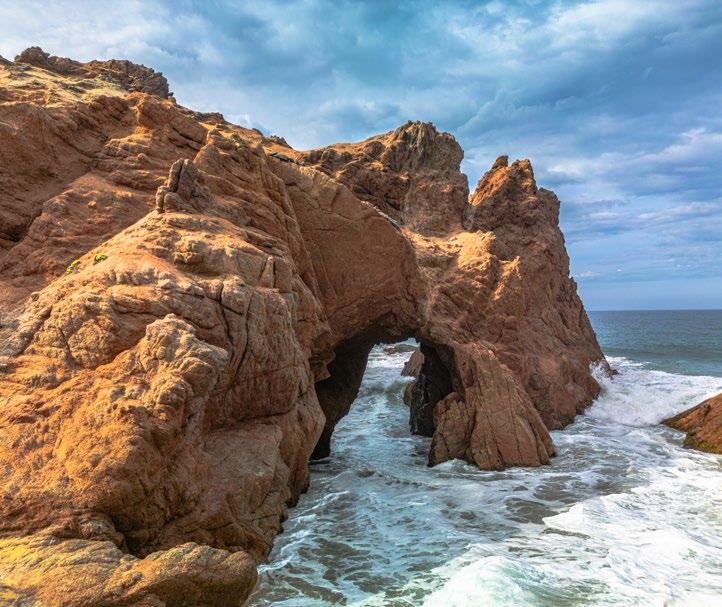
"You might say you want offgrid, but then you're driving an hour for groceries or medical care. You have to be honest about what you're looking for."
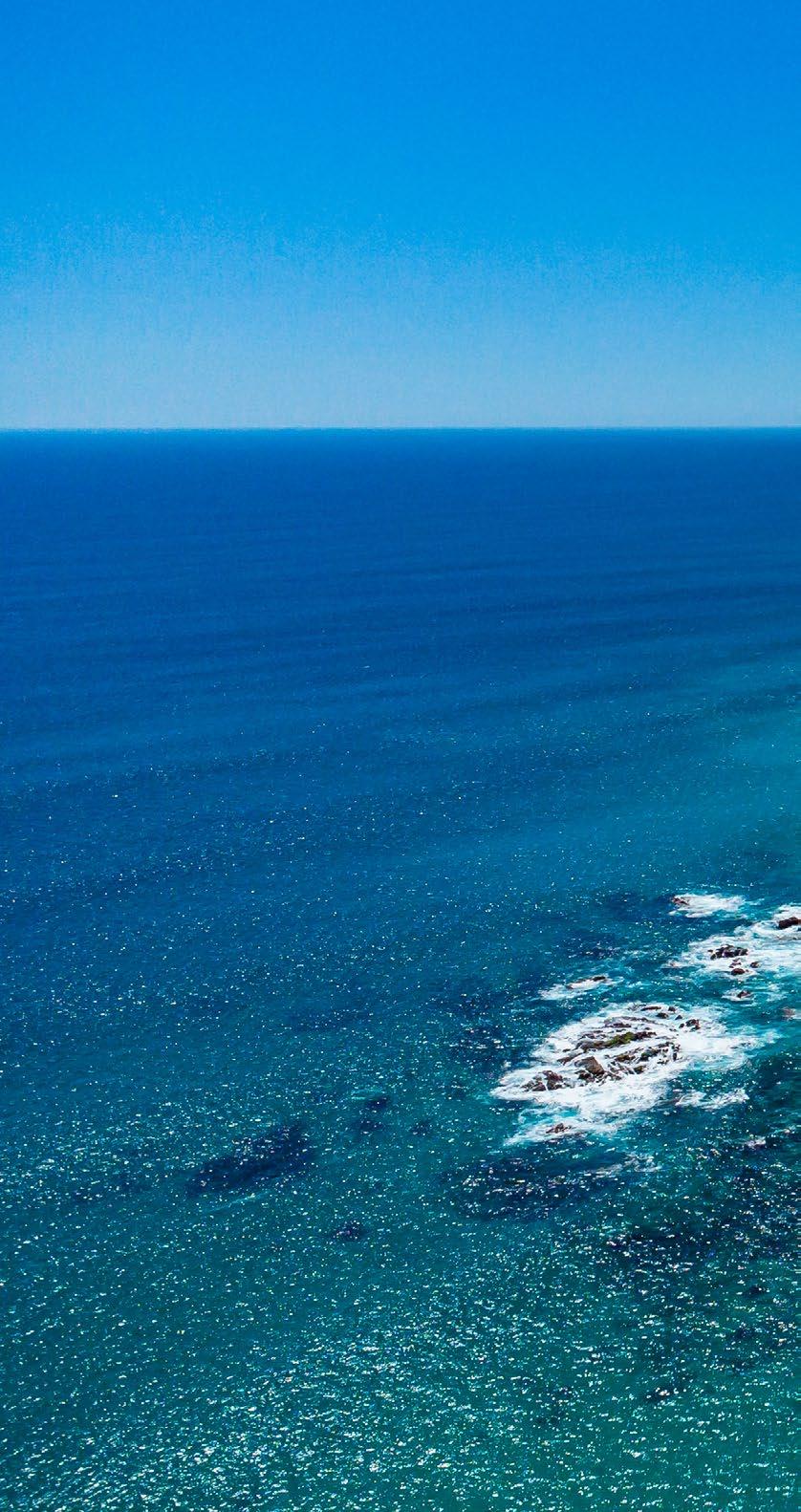
Oversupply and ego-driven projects are a growing risk
One of the easiest mistakes a buyer can make in Baja today is assuming that all pre-construction opportunities are essentially the same.
"You've got developers launching towers in areas that already have over two years' worth of inventory on the market," Fletcher says. "It just doesn't make sense."

In Tezal, for instance, one of the areas of Cabo San Lucas that experienced the biggest post-pandemic boom, months of inventory for condos and homes have crept well beyond what the market can currently absorb, yet new projects continue to emerge.
Some of this may be due to ego. Out-of-town developers arrive with a history of success elsewhere, such as Tulum, Cancun, or Playa del Carmen, and assume the same formula will work in Cabo. But Cabo isn't a blank canvas. It has an informed buyer base, a visible inventory pipeline, and infrastructure challenges that are not apparent in a glossy rendering.
"We've turned down projects that didn't make sense. One we rejected has been sitting on the MLS for months without a sale. Meanwhile, the developers are pricing as if there's no competition, and three lots down the road, another project is getting ready to launch."
Buyers don't need to know every metric. But they do need to know that not all projects have the same fundamentals. You need to examine supply and demand on a micro level. What's happening in this part of town, for this type of product, right now?
Should You Buy in La Paz, Loreto, or East Cape Instead of Cabo?
Alternative markets are rising. Yet they are not risk-free
With prices rising in Cabo and preconstruction margins shrinking, more buyers are exploring alternative markets, such as La Paz, Loreto, and the East Cape. These places promise lower entry points and the feeling of getting in early. However, what buyers are theoretically chasing often differs from what they want in practice.
"There's this idea that La Paz or Loreto is the next Cabo," Fletcher says. "And in some ways, they are. But when people get into the details, such as flights, healthcare, infrastructure, or the rental market, they realize Cabo offers things those towns can't."
Know what you're giving up when you go off the grid
In some regions of the East Cape, for instance, inventory growth has been explosive, but it has been off a very low base. And while demand is rising, services are limited, and the long-term liquidity of the market is still untested.
Inventory and Timing
Why high inventory isn't necessarily bad
For many buyers, rising inventory triggers alarm bells. But that's not always the proper reaction. High inventory isn't inherently bad. What's problematic is having no inventory or only poor-quality inventory. That's when markets get distorted.
More options can be a good thing, especially in a region like Baja, where delivery timelines can be lengthy and the finished product is still scarce. In the U.S., tight supply has kept would-be sellers from moving and driven prices markedly upwards. In Cabo, the buildup of homes and condos offers breathing room.
Ultimately, the difference-maker is sound judgment. Who's building it? Why are they building it now? What's happening in this micro-market, at the neighborhood level, that doesn't show up in the headlines?
A good agent can help answer those questions. A curious buyer can ask them. And somewhere in between is where the smart deals get made.
While much of the market shift has been most visible in the mid-range segment, similar dynamics are playing out in the higher end, just with different signals.
Buyers aren't chasing short-term wins as aggressively. They're asking more profound questions: What kind of life does this place support? Can we raise a family here? Stay longer? Build something lasting?
"We're seeing more families making this their primary home or spending most of the year here."
Developers often aim high, building multi-million-dollar homes in areas with fragile infrastructure and limited accessibility. "Everyone wants to do the next Costa Palmas, an ultra-high-end residential community in La Ribera.But sometimes what the market really needs is something more like La Ventana: affordable, grounded, and community-driven."
For buyers, the takeaway isn't to avoid these regions, but to understand the tradeoffs. A lower price point may come with fundamental limitations, including fewer direct flights, longer construction times, and a more challenging resale.
"You might say you want off-grid, but then you're driving an hour for groceries or medical care. You have to be honest about what you're looking for."
Use judgment, not headlines, to read the market
The critical question isn't how much inventory exists, but what kind of inventory it is. Is it priced appropriately? Is it buildable? Does a serious developer back it?
Timing also matters, often more than most people think. You can have the right project at the wrong time, and it won't sell. Some developers are learning this the hard way, launching into markets that aren't ready. Buyers, too, need to calibrate: a project that felt too risky last year might make sense today, and vice versa.
That's especially clear at Querencia, a private community in San Jose del Cabo known for its refined but understated approach. "We're seeing more families making this their primary home or spending most of the year here," says Anthony Solier, real estate advisor at Querencia. "People are enrolling their kids in schools and building long-term plans, not just buying vacation properties."
It's a sentiment that mirrors the broader cooling of speculative appetite across Los Cabos. Cabo isn't just a market anymore. It's a place people are choosing to inhabit more fully. For developers and buyers alike, that signals a deeper recalibration: the new fundamental value may lie less in price growth and more in livability. In communities designed not just to impress, but to sustain.
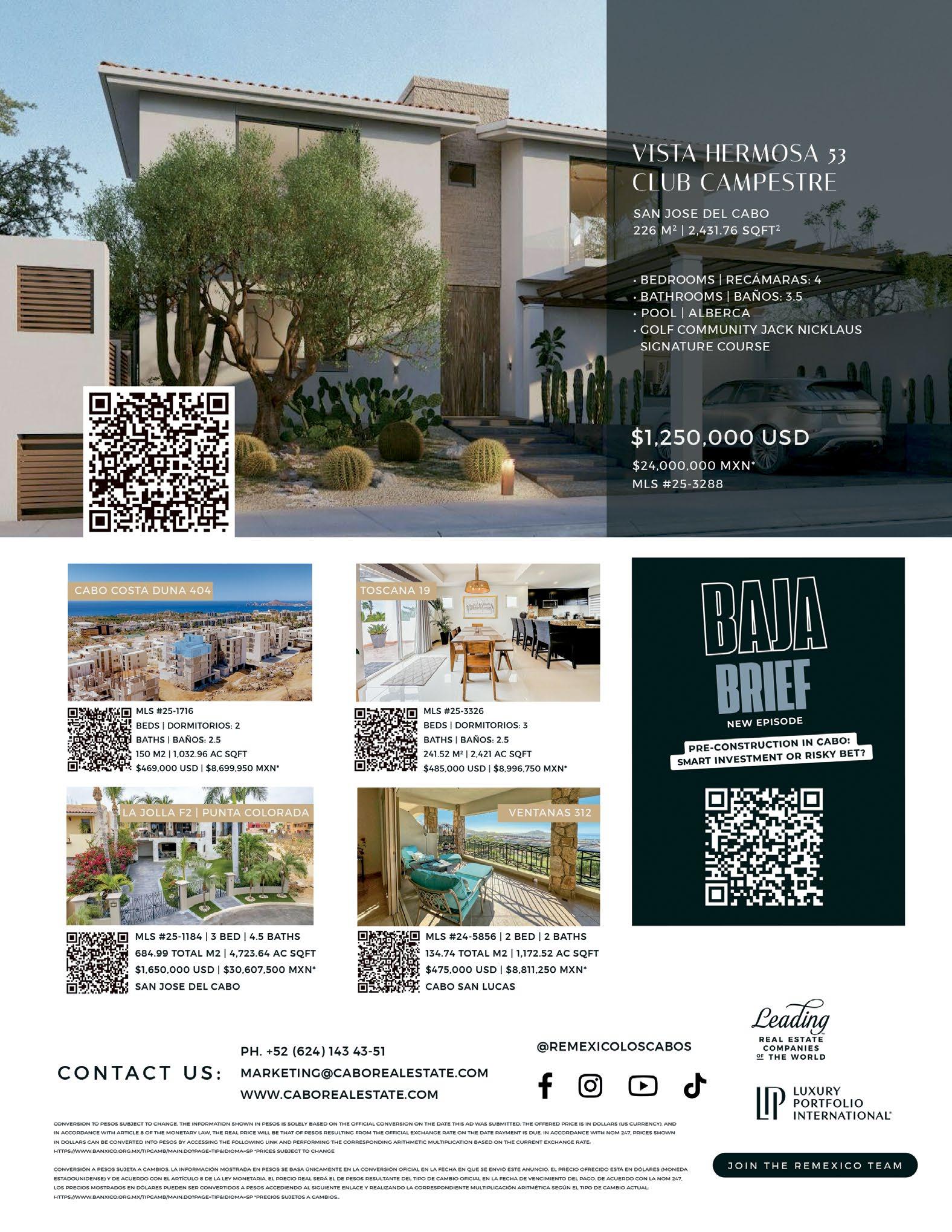
From the top of Gavilan Hill, you can see everything. Cerritos Beach stretches south in a long curve, its surf breaks framed by a patchwork of rooftops and construction sites. To the north, the land flattens along San Pedrito and the green rows of Pescadero's farmland.
In every direction, the view is open and uninterrupted. The wind is stronger up here than you'd expect: cool, crisp, sharp. Cabo San Lucas is under an hour away, yet it seems like a different world.
Below, pockets of development break the landscape: a row of homes, a crane, a half-paved road. But for every sign of construction, there's still raw desert. Still silence and space. From this vantage point, the idea that Cerritos is overbuilt doesn't hold. The story here isn't about what's been lost. It's about what's just beginning.
Karina Christensen, a real estate professional with Ronival Real Estate who lives and works in Cerritos, put it simply: "Cerritos is growing up."
That change is visible now from almost any hilltop, but it didn't happen overnight. Over the last four years, this quiet surf town has undergone a shift toward design, higher price points, and more intentional development. Buyers and projects are different. The town still feels small, but the stakes are getting bigger.
The question is no longer if Cerritos is growing. The question is how, and what kind of place it's becoming.
How Cerritos, Baja Sur, Became a Real Estate Hotspot
From Surf Camp to Luxury Destination
Not long ago, Cerritos was little more than a surf break with a few dirt roads and scattered homes. Prices reflected that. "Up to four years ago," Karina says, "you could buy a condo here for less than USD 200,000." That's no longer the case.
COVID accelerated everything. Travelers discovered Cerritos when international travel came to a halt. Some stayed. Others came back with plans to build. At the same time, a quieter shift was underway: buyers who had once purchased in Cabo were looking for something new. Not because Cabo had failed them, but because Cerritos reminded them of what Cabo used to be. Open. Lowkey. More space, less noise.
"They still want Baja, but they want a different kind of experience now." Many already own property in Los Cabos. Some are selling and relocating entirely. Others are buying second or third homes, drawn not just by the price, but also by the atmosphere.
The buyer profile has changed. So has their taste. "People now are looking for design. They want views, walkability, light. They want homes that feel unique, not just another unit in a building." Developers have taken note. The projects coming online in Cerritos are not only more expensive but also more refined.
The story isn't merely about rapid growth. It's a story about deliberate repositioning. Cerritos isn't trying to be the next Cabo. It's becoming something else: a boutique alternative for those who still want Baja, but with a quieter rhythm.
High-End Homes, Low-Density Projects: Cerritos' Boutique Evolution
The shift in Cerritos isn't being driven by a single developer or master plan. It's happening one project at a time. Small-scale, distinct in character, and shaped by people who have a point of view about what this town should become.
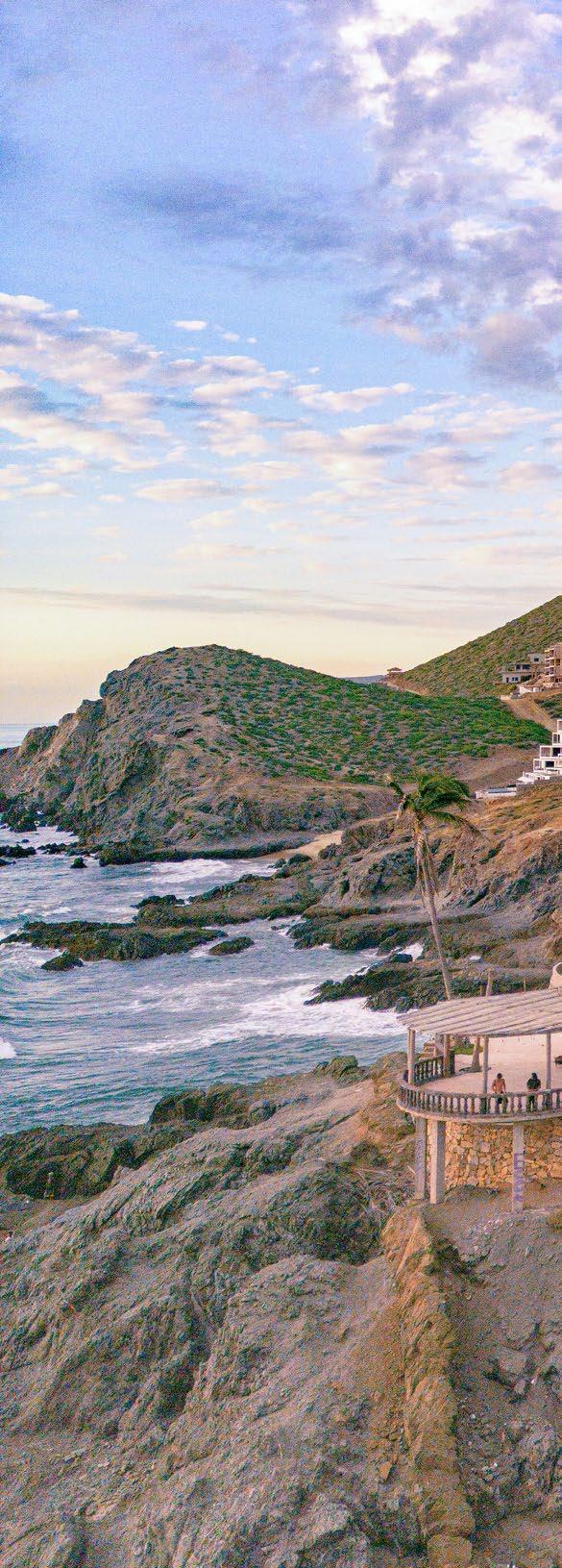
"It's the heritage of Cerritos, you wake up under a palapa, hear the waves, and you're on the sand."
Moon Over Cerritos: Architecture That Honors the Land
At the top of Gavilan Hill, Moon Over Cerritos is strongly signaling a different direction. Developer Erick Sanchez and his family found the site three years ago. At the time, there was no road to reach the summit. The land was bare. His daughter, then just learning to walk, picked up a rock encrusted with crystals from the ground and held it out. That moment
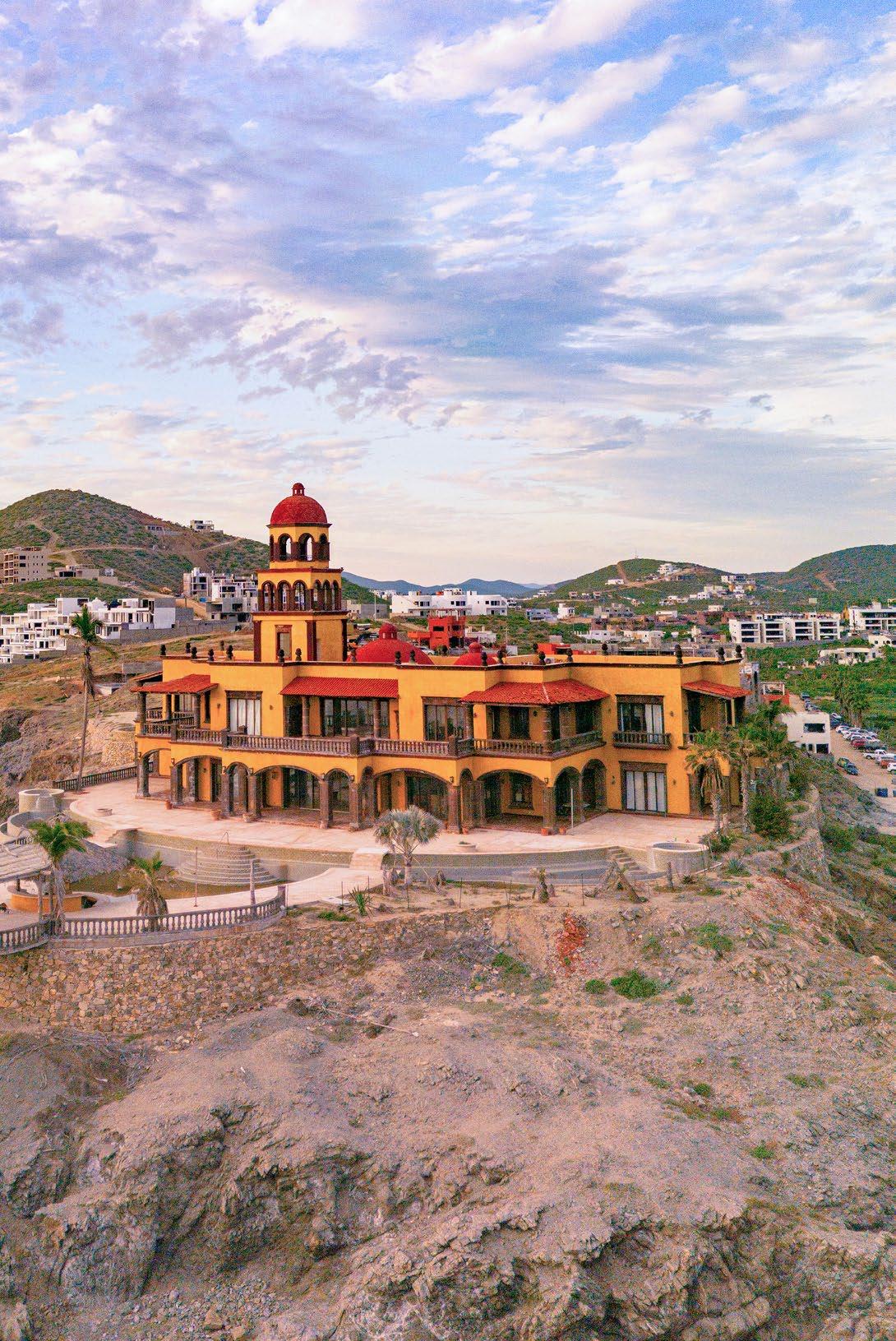
stuck. They decided to build here. Two out of three projected homes now sit quietly on the slope. Each one is designed with care, not scale. "For us, luxury isn't extravagance," Erick says. "We didn't want to build something that overwhelmed the land. The mountain is bigger than us. It deserves respect." The homes — Casa Luna, Casa Celeste, and a third still in progress — are oriented to preserve sightlines in every direction. The views are permanent. No one can build above or in front of it.
A few minutes away, another approach is taking shape. At Oasis del Mar, developer Lorenzo Messina began by building the pool. Before the homes, before the sales. He wanted the place to feel like it was already a community. "We're not just selling property," he says. "We're building something people can thrive in."
Messina, who grew up near the ocean in Southern California, sees the same arc playing out here. "This feels like Malibu in the sixties," he says. "You're watching a beach town form, one house at a time." His project includes ten single-family homes and four townhouses, all centered around shared space and set on the only paved road in Cerritos. It's quiet, walkable, and four minutes from the beach.
Cerritos Surf Town: A Legacy Development Turns the Page
Not every project is new. Cerritos Surf Town has been a fixture in the area for nearly two decades. With its palapa roofs and beachfront layout, it defined the early Cerritos' look. Today, the owner is selling it individually as titled condos, with in-house property management and strong rental appeal. "It's the heritage of Cerritos," Karina says. "You wake up under a palapa, hear the waves, and you're on the sand."
Serenity at Cerritos: Low-Density Living Near the Beach
Other developments are also emerging in the area. A case in point is Serenity at Cerritos, a low-density project located just a short walk from the beach. This development features 15 three-bedroom condos spread across five separate buildings, each with private terraces and ocean views. Shared amenities, such as a heated pool, fire pit, and shaded BBQ terrace, are designed to provide comfort without overcrowding.
Each project reflects a different style. But taken together, they offer a shared answer to the same question: what does it mean to build thoughtfully and with intention in a place like this?
Inside Cerritos' Two-Speed Market: Oversupply vs. High-End Demand
Why USD 500K Condos Are Sitting, but USD 1M+ Homes Are Selling
If the top end of the Cerritos market feels lean and competitive, the lower end tells a different story.
"We ran some numbers recently," Karina says. "At the current pace of sales, there's enough condo inventory under USD 500,000 to last six years." The oversupply isn't just in pre-
construction. Even finished units are sitting. It's a segment flooded with similar offerings, many of which were built in the rush of the last few years: compact layouts, limited views, and basic finishes.
At the same time, homes priced above USD 700,000 are selling. In fact, according to Karina, the strongest segment right now is between USD 1 million and USD 3 million. These aren't speculative builds. They're welldesigned, ready-to-move-in properties with views, privacy, and walkability. What they lack is a massive volume. Inventory in this segment is thin.
The split is clear. Price alone isn't driving demand. Design, layout, and location matter more. So does credibility. Projects that are funded, permitted, and physically underway get attention. Buyers today are cautious. Many have seen delays. Some have been burned. They're willing to pay more for homes that are already standing.
Developers like Erick see the stakes. "The problem isn't growth. It's bad growth. A 200unit development here doesn't just stretch infrastructure. It changes the town for the worse."
There's tension in that. Cerritos is still early in its curve, but the speed and shape of that curve aren't guaranteed. For now, the strongest momentum is in small projects with a clear point of view, and in buyers who aren't looking for a deal, but a place that feels right.
What Makes Cerritos, Baja Sur, Different from Cabo or Todos Santos?
Cerritos doesn't borrow its identity from anywhere else. It's not Cabo, though it shares the same sun and sea. It's not Todos Santos, though it's only twenty minutes away. And it's not Pescadero, even if they share a coastline and a ZIP code.
What Cerritos offers is more physical. The surf is right there. The beach is swimmable. The restaurants are walkable. There's no plaza, no gallery circuit, no cobblestone charm. What you get instead is rhythm. An outdoor, barefoot rhythm built around the waves, the light, and a growing mix of people who come here to reset.
Karina sees this every week. "There's not much crossover. People who fall in love with Cerritos tend to remain focused on this area. It has a different energy." She
describes Pescadero as quieter and more rural, while Todos Santos is more historical. In contrast, Cerritos is still rough around the edges in some areas, but it has an energy that continues to grow.
The restaurant scene is evolving. There are discussions about improving infrastructure and adding more amenities. However, the pace of these changes remains inconsistent. On any given afternoon, you might surf in the morning, enjoy fresh seafood for lunch, and then head home on a bumpy dirt road that tests your vehicle's suspension. This combination is part of the area's appeal, at least for the time being. While it's tempting to label this as charm, it's essential to recognize that this charm is delicate.
From the top of Gavilan Hill, the story becomes clearer. You can see the shape of the town and where the houses stop and the desert begins. Despite all the movement, Cerritos is still in its early stages. The rising prices and the emergence of new types
of buyers are all real, but the development is still small, uneven, and open to interpretation.
That's part of what makes this moment important. The decisions being made now by developers, local officials, buyers, and the local community will shape what Cerritos becomes. The outcome isn't guaranteed; the dynamics can change. The balance between growth and restraint is delicate, and everyone is aware of it.
There's something unique about this town. It has a sense of possibility, still visible in the gaps between buildings. The luxury isn't only in the homes; it's in the space, the light, and the silence that still exists between waves of change.
Erick put it this way: "We're not just building homes. We're building a future people will want to live in."
"This feels like Malibu in the 1960's. You're watching a beach town form."
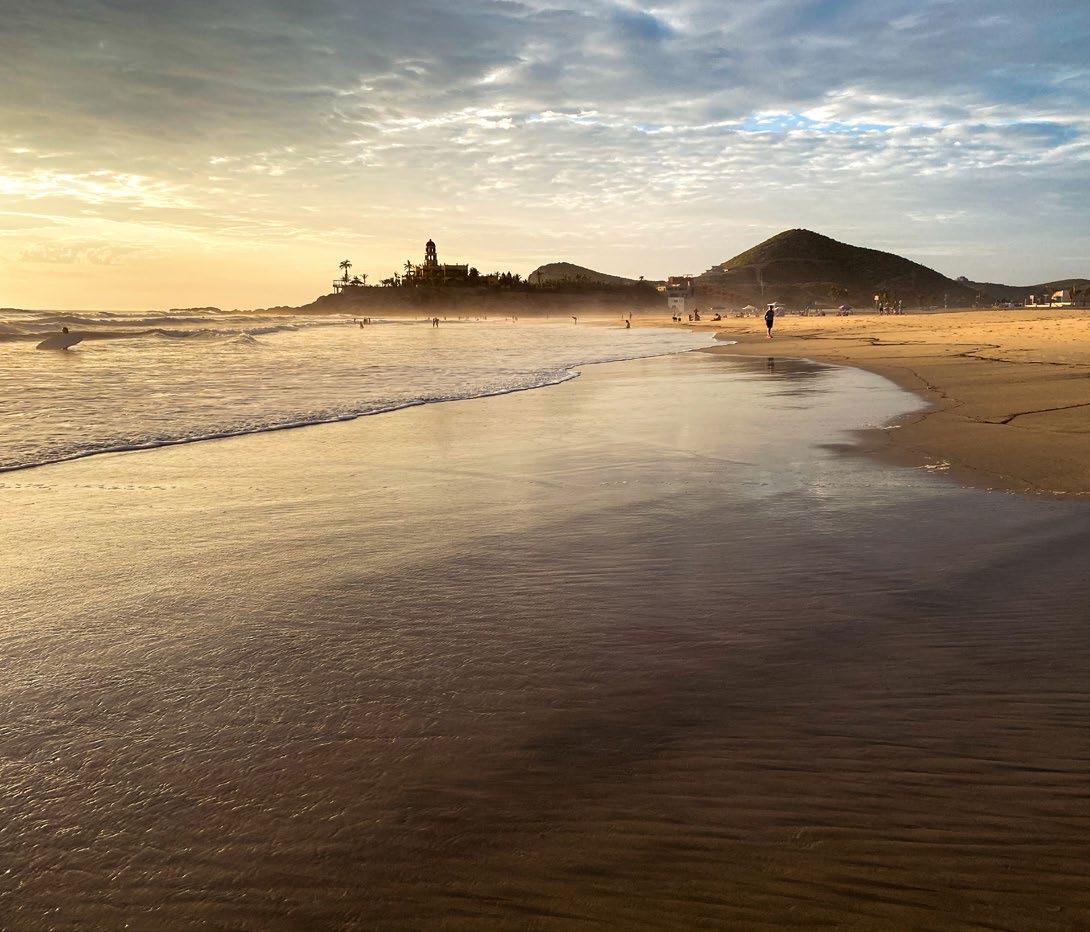

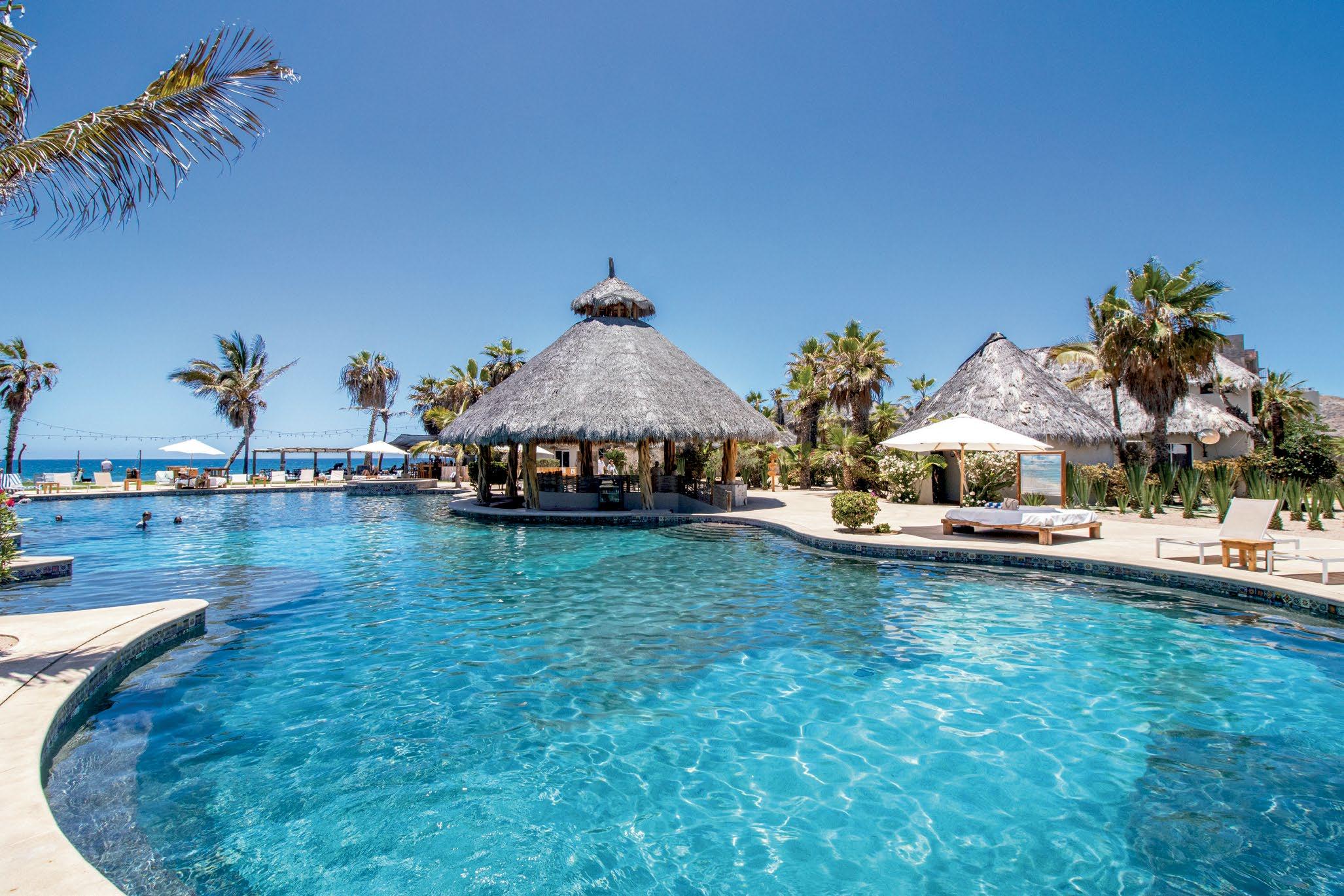
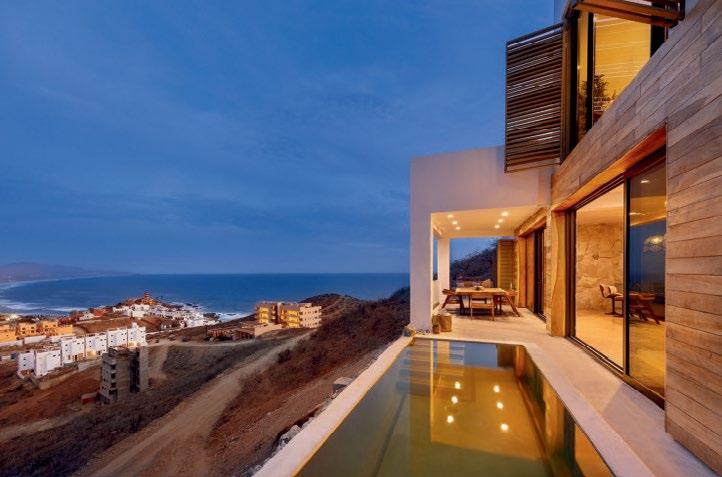




“It has the same kind of landscape as Palm Springs… but with the ocean… a very unique place.”
For decades, Loreto remained one of Baja California Sur's quietest towns. It attracted dedicated sportfishers and history enthusiasts drawn to its 17th-century Jesuit mission and the surrounding marine reserve. Visitors came purposefully, willing to travel farther for a destination known for its remoteness, natural beauty, and small-town rhythm, far removed from the fast pace of Los Cabos.
That is changing. A new generation of developers and buyers is rediscovering Loreto as a place that combines low-density living, strong community ties, and direct access to nature, all within an environment of comfort and security.
Danzante Bay, a master-planned community, has been a catalyst for this shift. It prioritizes space and natural landscape, limiting density, protecting the open beachfront, and integrating amenities like a golf course that is shaped by the land and sea.
Loreto's rise reflects a different approach to growth. It is purposeful, measured, and rooted in the character of the place. In a market crowded with high-rise resorts and sprawling developments, Loreto offers something increasingly unusual: space, simplicity, and a deep connection to its surroundings.
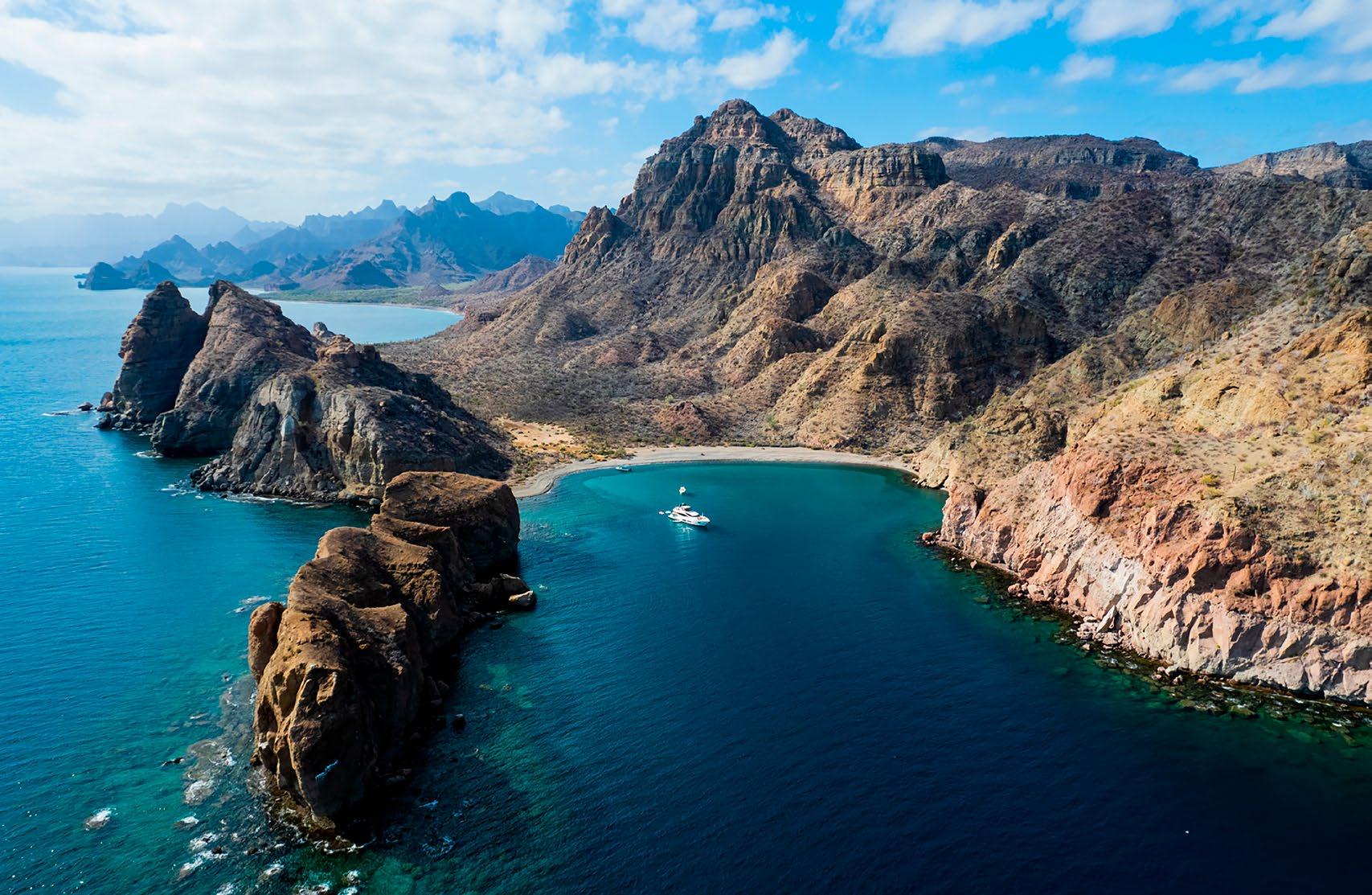
Vision: A Development Model Rooted in Place
Loreto's evolution reflects decisions by developers who recognized value where others overlooked it. Owen Perry, a veteran of Mexico's resort sector, first discovered Loreto while sailing the Sea of Cortez. He was struck by its contrasts: the Sierra de la Giganta mountains rising from desert plains, the turquoise waters offshore, and the absence of sprawl or congestion.
Loreto had infrastructure — an airport, paved roads, and utilities — yet its pace remained slow. More importantly, it held a sense of permanence, grounded in history and protected by its natural setting.
At Danzante Bay, Perry shaped a development model built around restraint. The 6,000-acre master plan limits residential parcels, letting the land frame the experience. Amenities, including the TPC Danzante Bay golf course, are designed to enhance the scenery rather than dominate it.
The project does not impose a destination, but instead highlights what Loreto already offers, including its natural beauty, spaciousness, and an enduring connection to the place. "We wanted to keep the natural essence of Baja and the natural beauty of our property. The golf course is part of the land, not something forced onto it," Perry notes.
The Market Today: A Steady Shift in Buyer Demand
Loreto's market grows through consistent demand from buyers who prioritize lifestyle over speculation. James Hansen, sales director at Danzante Bay, notes that most clients are Americans, as well as Canadians and affluent Mexicans from mainland cities. They buy with long-term use in mind — whether as seasonal retreats or future residences — not for quick resale.
"There's still value here, but people are realizing it," Hansen says. Prices at Danzante Bay have increased by 15% to 30% in recent years, with approximately 60% of the inventory remaining. Sales activity has increased since 2023, and local appreciation rates now surpass both national and regional averages.
Buyer preferences have also shifted. More buyers choose readybuilt homes for immediate use, while others opt for custom builds. "We want people to have options," Hansen notes.
Compared to Los Cabos, Loreto remains more accessible. Sea-view homes with resort amenities are attainable, direct flights ease access, and the town's smaller scale offers a slower, more grounded lifestyle. Market growth has accelerated, but on stable footing, driven by people investing in how they want to live.



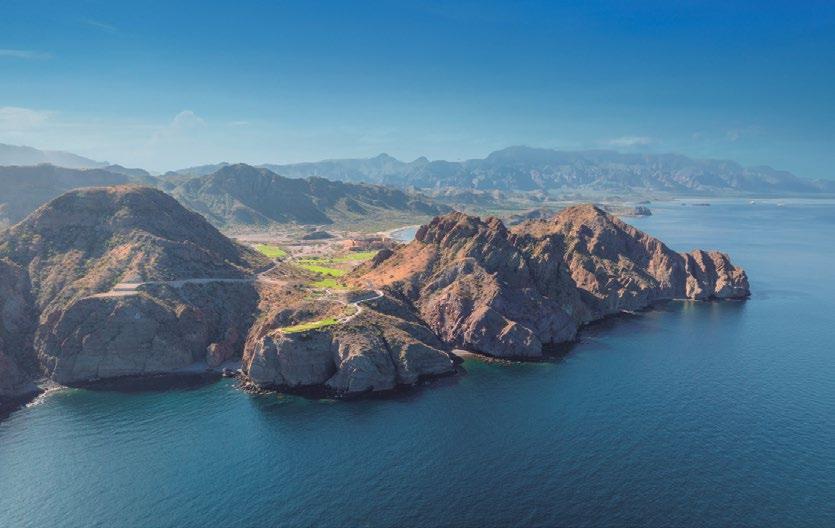

Defining the Lifestyle: Space, Simplicity, and Nature
Loreto draws people in with its simplicity and natural beauty. Residents enjoy open beaches, calm bays, and a town where neighbors know each other by name.
“It has the same kind of landscape as Palm Springs… but with the ocean… a very unique place,” Perry says. Life is slow and easy, revolving around outdoor activities such as paddleboarding, hiking in the Sierra de la Giganta, and spending time in a safe and welcoming community.
Danzante Bay aligns with this rhythm. Its recreational spaces, including the golf course and beach clubs, are built to complement the landscape. Homes are spaced to preserve privacy, and the community favors relaxation over spectacle.
Loreto's surroundings shape daily life in ways few destinations can match. Many connect with nature from the shoreline; others explore from the air. One of Perry's latest ventures, Island Tours Mexico, offers helicopter flights over Loreto's marine park and islands, providing residents and visitors with sweeping views of the untouched coastline and the jagged peaks of the Sierra de la Giganta.
Homeownership blends lifestyle with investment. Short-term rentals yield between 10% and 14% in well-positioned properties, with demand strongest from winter through spring.
Loreto's growth is shaped by geography and intent. The Sea of Cortez borders it to the east, the Sierra de la Giganta to the west, and marine protections limit unchecked development along the coast.
At Danzante Bay, only 88 home parcels exist within the master plan. "You're not going to see a skyline here," Perry says, pointing to space as Loreto's defining feature.
Inventory is tightening and prices continue to rise, but at a controlled pace. Buyers still have choices between custom homes and ready-built options, but availability is steadily declining.
Market fundamentals reinforce this trajectory. Home values in Loreto are remarkably resilient. Air connectivity is improving, and tourism has broadened beyond fishing to include golf, wellness, and extended seasonal stays.
Growth will continue, but on Loreto's terms, shaped by natural limits, community preferences, and long-term value.
Loreto has carved out a distinct place within Baja's evolving market. It resists the rapid development of larger resort hubs, opting for a path of controlled, small-scale growth.
Its draw lies in open space, a pace of life in tune with nature, and a community that values connection over congestion. Loreto's trajectory is steady, rooted in authenticity, and built to last.
For buyers, the opportunity remains tangible. Infrastructure has improved, amenities are established, and the essence of the town endures. Loreto's growth focuses on quality over quantity, featuring fewer properties, greater long-term value, and a lifestyle rooted in the natural beauty of Baja.
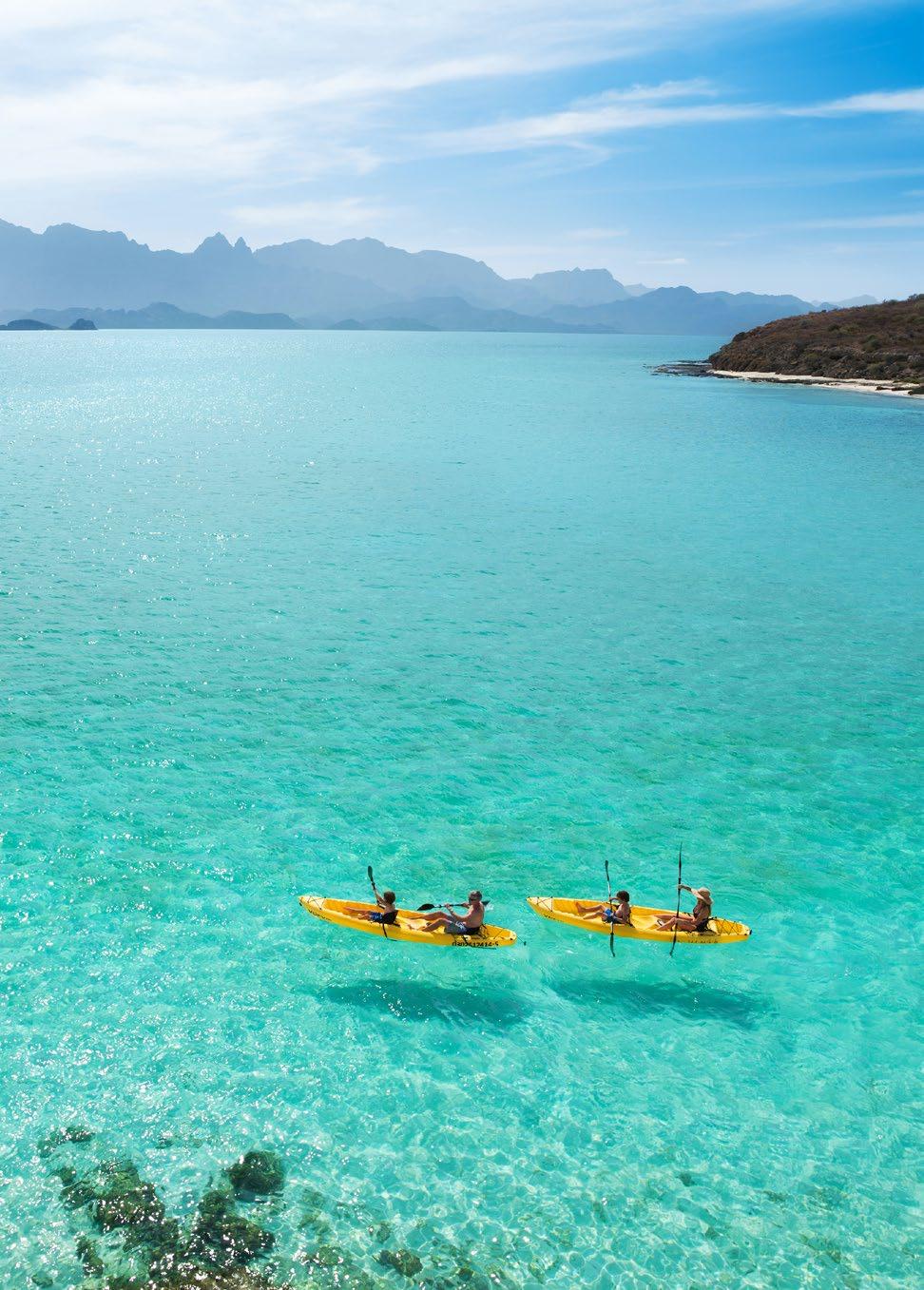
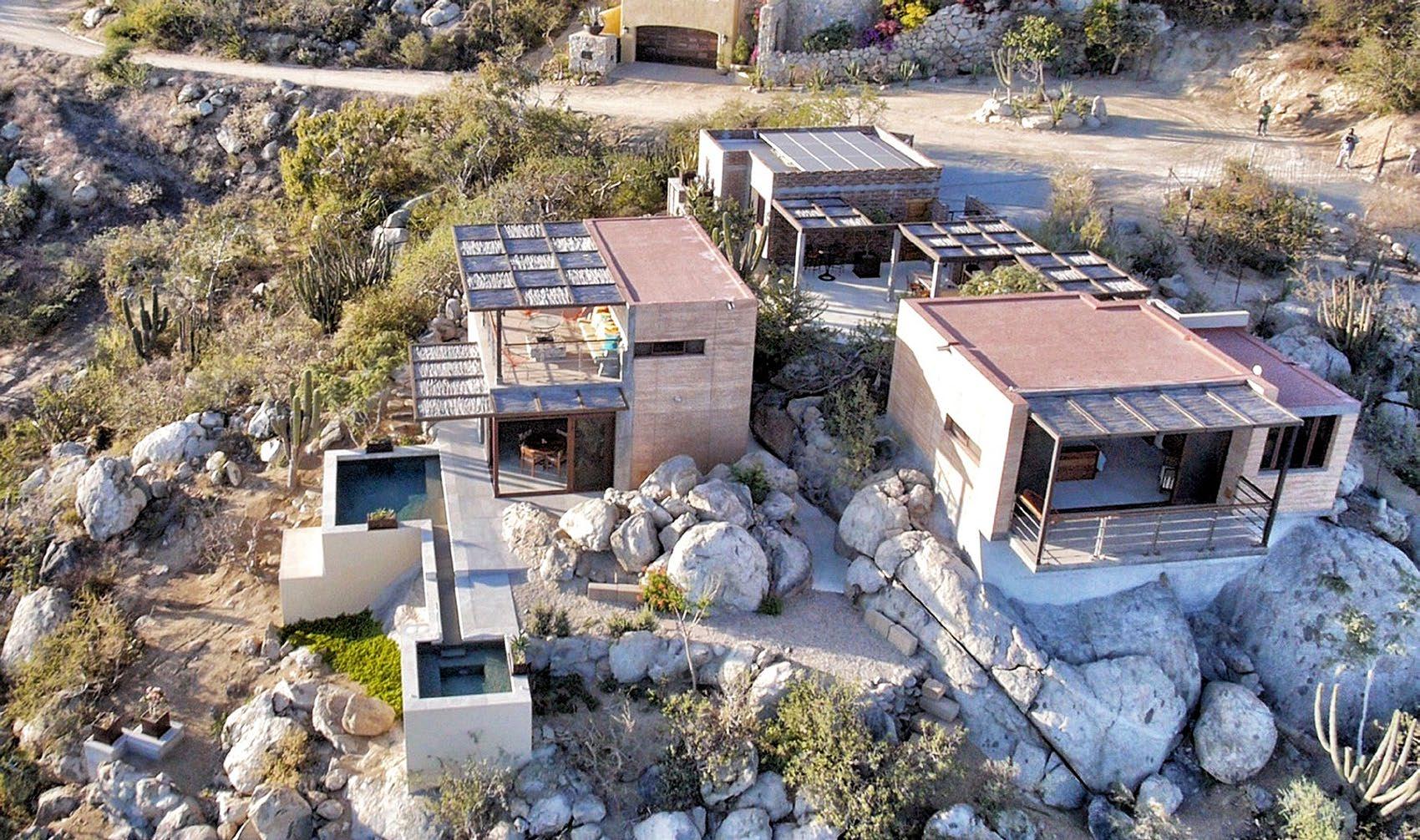
Designing and building a home in Baja California Sur means more than picking finishes or chasing views. It's a process shaped by climate, materials, logistics, and how people actually live here.
We spoke with three professionals who understand that from the inside out: an architect, an interior designer, and a builder. Each brings a different lens, but all agree on one thing: success comes from working with local conditions, not against them.
From solar orientation to performance fabrics to construction oversight, the details matter. If you're planning to build, already own property, or are simply curious about how homes take shape in Baja, their insights offer a grounded place to start.
Gonzalo Elizarraras, fabriK°G:
In Baja, too many houses are designed like they could be anywhere: flatroofed boxes, ample windows, air conditioning running all day. Some are beautiful. But they fight the land.
I don't think you should fight the land. I think you should let it tell you how to build. That starts with orientation. You can't just unreflexively point the house at the view — unless you want to live in a glass oven.
We use passive solar design to cool the home naturally, and compressed earth walls to regulate temperature. The material is 90% soil from the site, with a small amount of cement. It breathes, it insulates, and it's hurricane-tested.
Designing this way also changes how you think about water, which is more precious than square footage here. We collect rainwater. We reuse greywater for irrigation. The idea is to make a home that needs less; not just less energy, but less repair, less maintenance, less effort to live in.
People ask about style. To me, the question is: What's the most resilient way to live here? That's the fundamental design challenge. If your house stays cool most of the year without AC, if it survives a storm without repairs, that's good architecture. In Baja, that means building with what the land already offers.
Barrie Livingstone, House of Barrie: Design for the Way People Actually Use Their Homes
In Cabo, you’re not doing a primary residence. This is a second or third home. It’s for family, friends, and guests. People entertain, they rent it out, they come for a few weeks or a few months, and the house has to be ready for that kind of life.
Everything has to function. Guest bedrooms need to feel like hotel suites. En suite bathrooms, a desk, a little surface where someone can sit with their laptop or do their nails, that kind of thing. You don’t need a sixdrawer dresser. You need surfaces.
And you can’t just pop out to HomeGoods. You can’t go grab lightbulbs or glassware. Everything has to be thought out, ordered, brought in. Towels, sheets, even lamps. We bring our own lightbulbs. That’s how it is here.
Also, no one tells you this, but concrete homes, which is how we build here, sound different. They echo. If you don’t have rugs, drapes, upholstered pieces, it all gets very clattery. We soften that, not just for style, but so the house feels comfortable.
I’m not interested in trends. Trends go out of style. What I care about is that when someone walks into the house five or seven years from now, it still feels beautiful. It still works. Form always follows function. We live differently in Cabo, so adapt and enjoy.
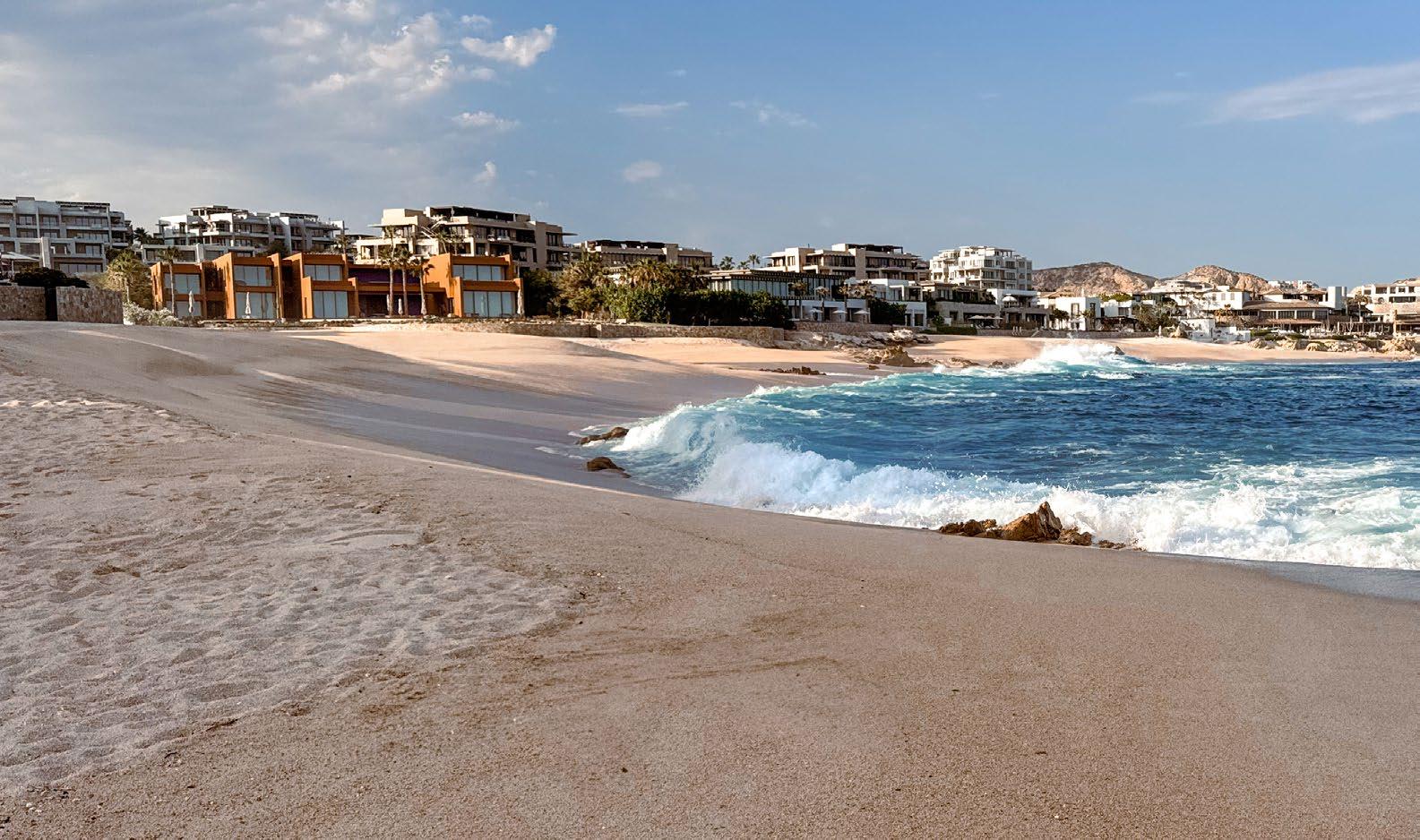
Borrayo, Der Bauunternehmer:
You
Most of the clients I work with are building their retirement home. They've dreamed about it for years. But dreaming and building are two different things.
Baja isn't like the U.S. We don’t build with wood. Permits require a complete executive project, including architecture, structure, plumbing, lighting, and data. Getting that approved can take three months or more.
I've seen clients bring in designs from abroad that don't meet local codes, or call for materials that are not available locally. The first step is understanding the context: land use, logistics, and what's actually buildable.
Then it's about transparency. I tell every client: shop around. If someone gives you a million-dollar quote on half a page, walk away. My budgets are 12–15 pages. You should know your materials, specs, labor, and finish level before you spend a dollar.
And unless you're living here full time, you need eyes on the project. I send weekly updates, photos, and walk-throughs. Trust is built through communication. It's not just about hiring a builder; it's about choosing a process you can depend on.
You only build once. So don't rush it. Don't cut corners. Build something you'll still want to live in twenty years from now.
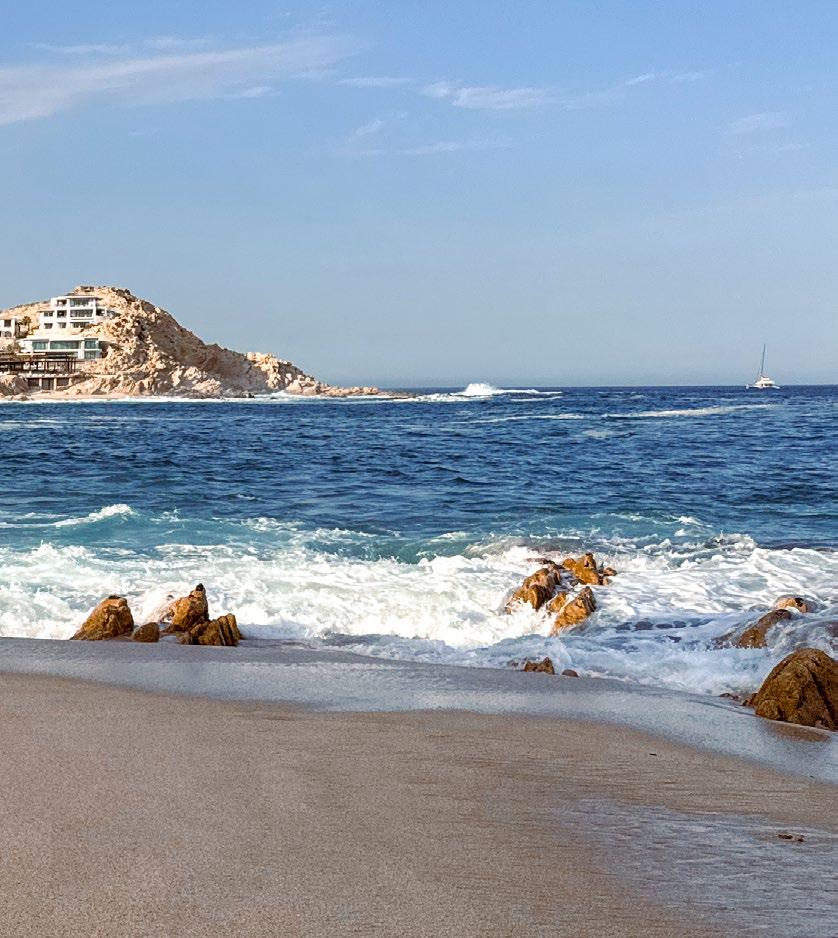
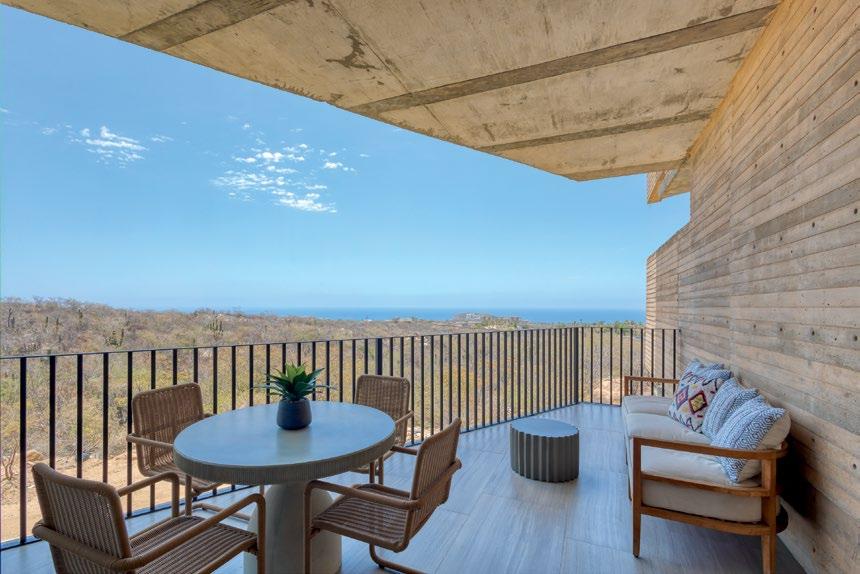

Presenting the chic OR Condominium #E205. A Boutique building of onlu 27 residences. Where celebrated Mexican architecture meets sophiticated Cabo style. Designed by Houseo Barrie and available for sale fully furnished, turnkey and move in ready.
At House of Barrie we treat every client and their property with dignity and respect. Always being creative yet thoughtful as to
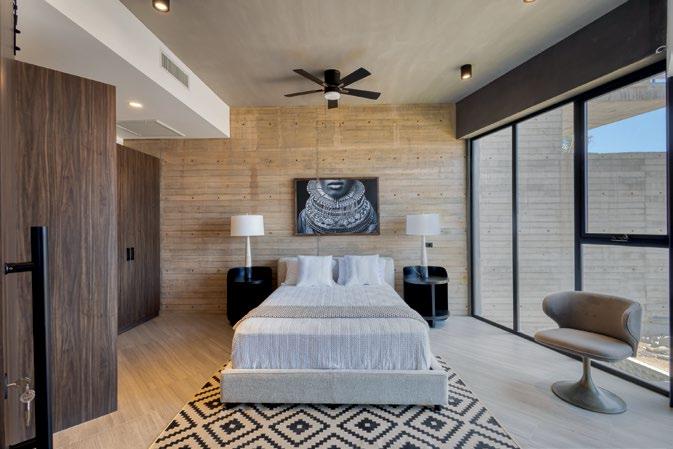



Baja California Sur’s vernacular architecture and the knowledge that shaped a land
Author: Rox Holsch
This photography series was born out of a question: What does traditional architecture look like — and what does it feel like — when it is not frozen in the past, but in living contact with the everyday?
Over the course of a year, we traveled long dirt roads, visited missions, rancherías, and working-class neighborhoods in growing towns like San Jose del Cabo. Our goal was to document the traditional abodes of Baja California Sur as a living fabric, rooted in the land and in memory.
What we discovered goes beyond adobe and vara trabada (a traditional wall-building method using palo de arco sticks interlaced like a weave and coated with earth). It’s not only houses that endure over time, but ways of inhabiting — an ethic of the essential; forms that speak with the climate, the desert, and the inherited knowledge.
Documenting vernacular architecture became a framework for revealing the memory of Baja California Sur, still beating in the pulse of everyday life. The legacy of the land we encountered is a tapestry woven from abandonment and permanence. The folk wisdom of the earliest settlers has kept remote communities alive along the edges of oases, where the proximity to water nurtures life.
Over time, ranch life settled across Baja California Sur. Farmers and cattle raisers learned to survive in what the first colonizers called “The Unconquerable Land.” Three hundred years after the founding of the 17 missions along the southern portion of the peninsula, only 12 remain. More than three centuries have passed of a culture shaped by mestizaje that continues to adapt and coexist with an arid land that seemingly has few natural resources.
This work — creating an archive that documents the construction of Baja California Sur’s traditional dwellings — has the purpose of remembering, making vivid a genuine recognition of the knowledge that allowed life to flourish in the first settlements here. It is about recognizing dwellings as containers of culture and sowers of the seed of civilization, and about fostering awareness of the inherited knowledge that can help us build a society that endures in harmony with its environment
In Baja California Sur, generational knowledge is mestizo. We cannot forget the wisdom that made it possible to inhabit a land like this. We are shaped by our geography, by the history of the territories we inhabit, and above all, by access to natural resources.
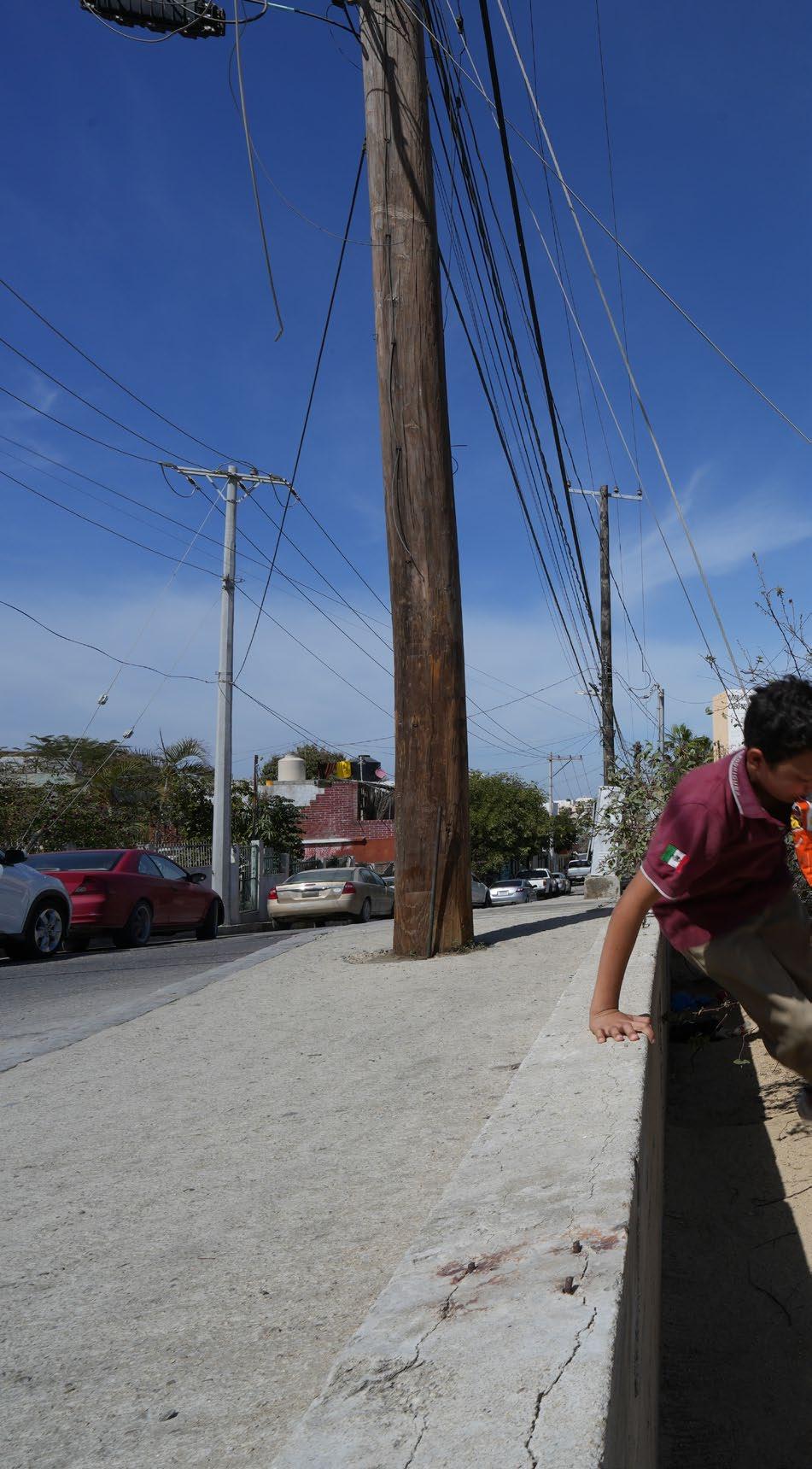
Baja California Sur’s vernacular architecture offers answers to the region’s kaleidoscope of climates, to food security in garden patios, and to the possibility of building with what the land itself provides, like adobe and palm leaves.
In this unique region at the meridional end of the peninsula, time follows a winding road — not rushing anywhere, simply passing by. Here, time doesn’t chase you; it keeps you company.
Research Team: Arturo Ojeda, Rox Holsch, Elisa Murillo, Brenda Martínez Sandoval
Editor: Rayru Fonseca
Photography: Rox Holsch
Original Text in Spanish: roxholsch.com
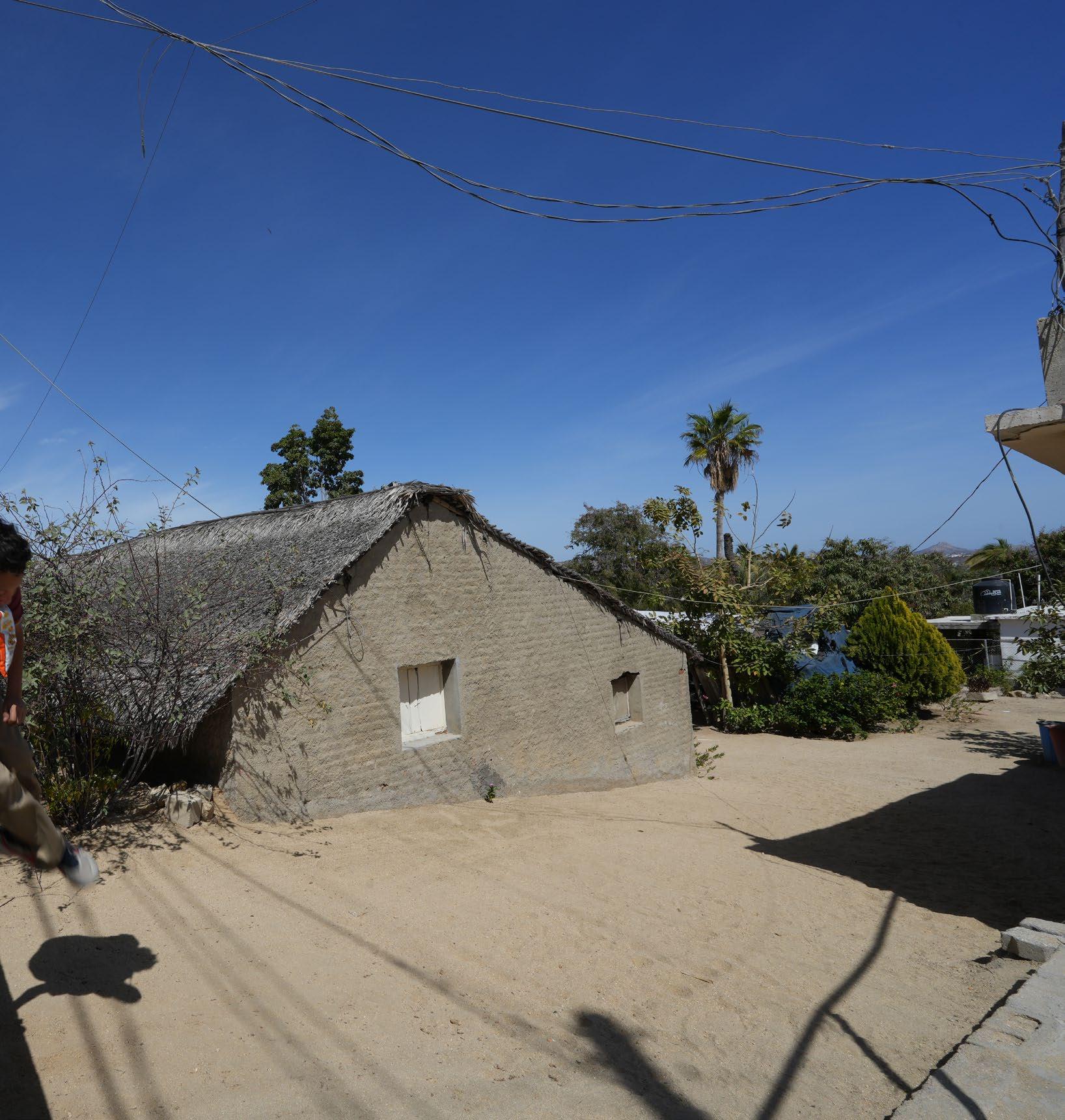
Built long before paved roads, this adobe house now sits sunken below street level, as if the modern city had risen around it. Its palm-thatched roof belongs to an older rhythm of life, yet here it coexists with asphalt, power lines, and passing cars. It reveals how histories overlap rather than erase one another.
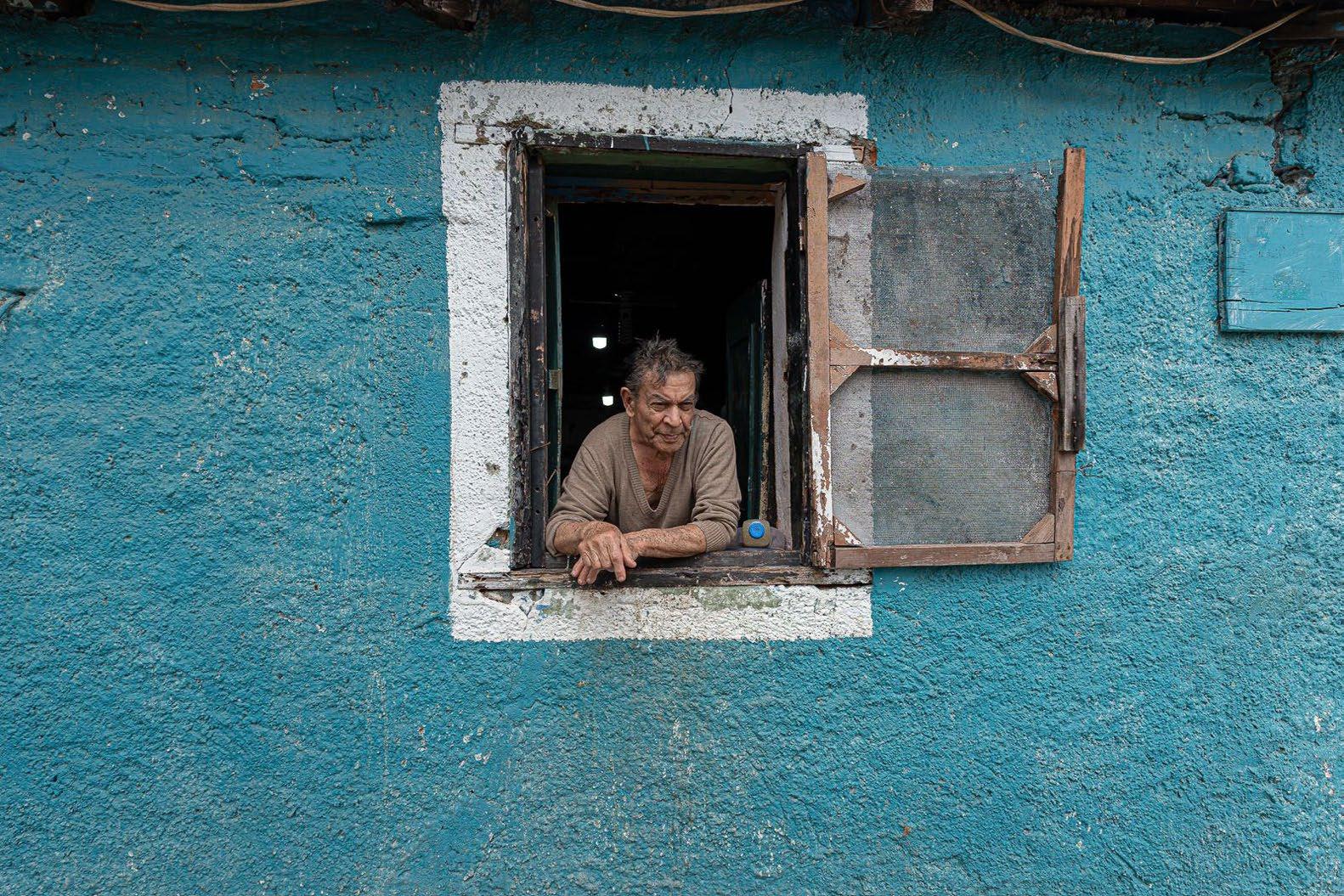
In Baja California Sur’s vernacular homes, the small window serves as a mediator between the desert and the dwelling: it frames the world outside while tempering its intensity, allowing light and air to enter gently yet keeping out the desert sun.
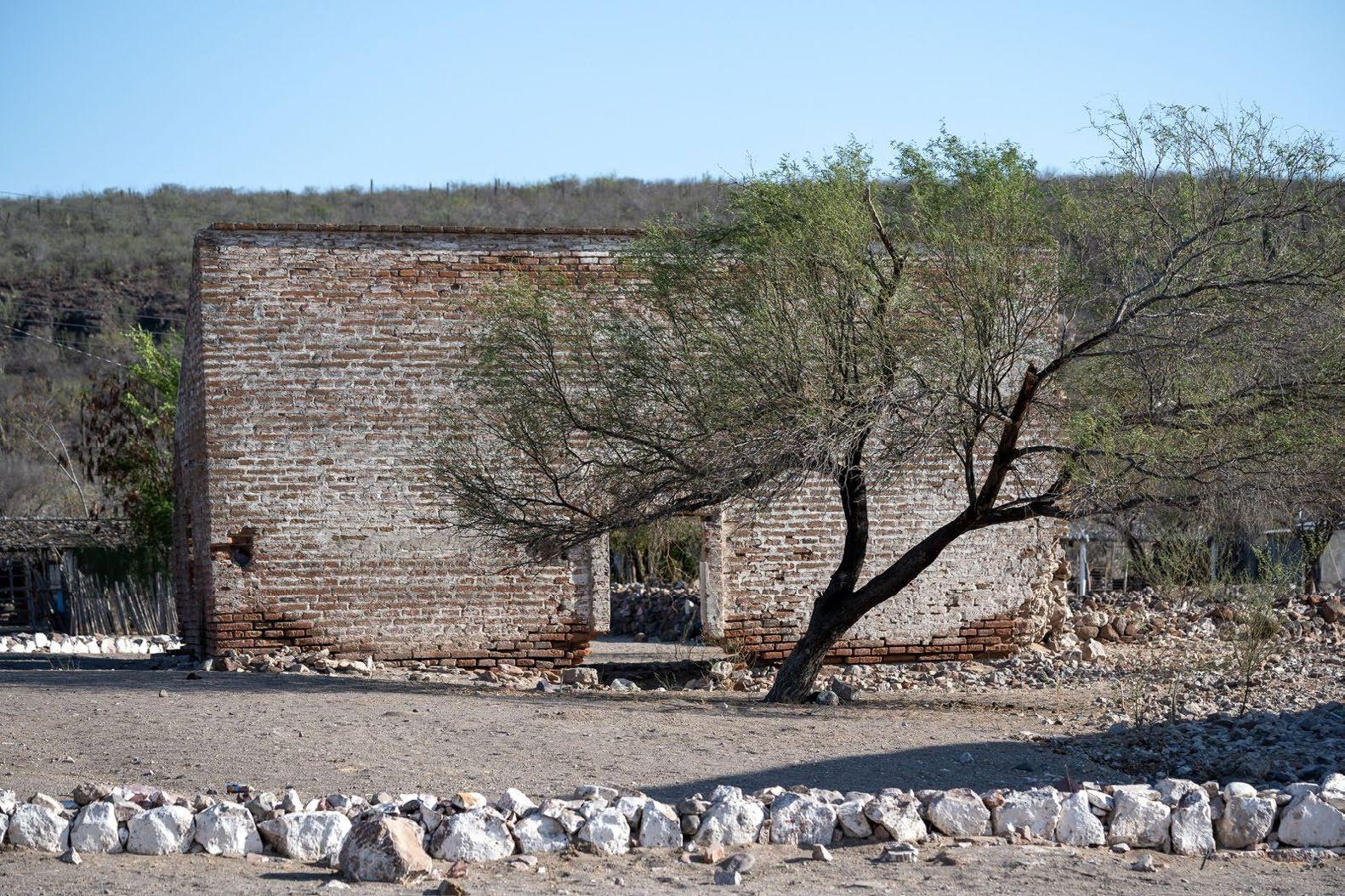
With the missionaries came the craft of fired brick and the first brickworks on the peninsula in the 18th century. More durable than adobe, brick marked a new architectural aspiration, reserved for public buildings and the homes of the powerful.
In San Luis Gonzaga — today reduced to a village of 14 inhabitants — the weathered arches of the old mission façade stand as quiet witnesses to centuries of desert life. Built of stone and brick, they speak less of status now than of endurance and memory, reminding us that these ruins remain part of a living landscape.
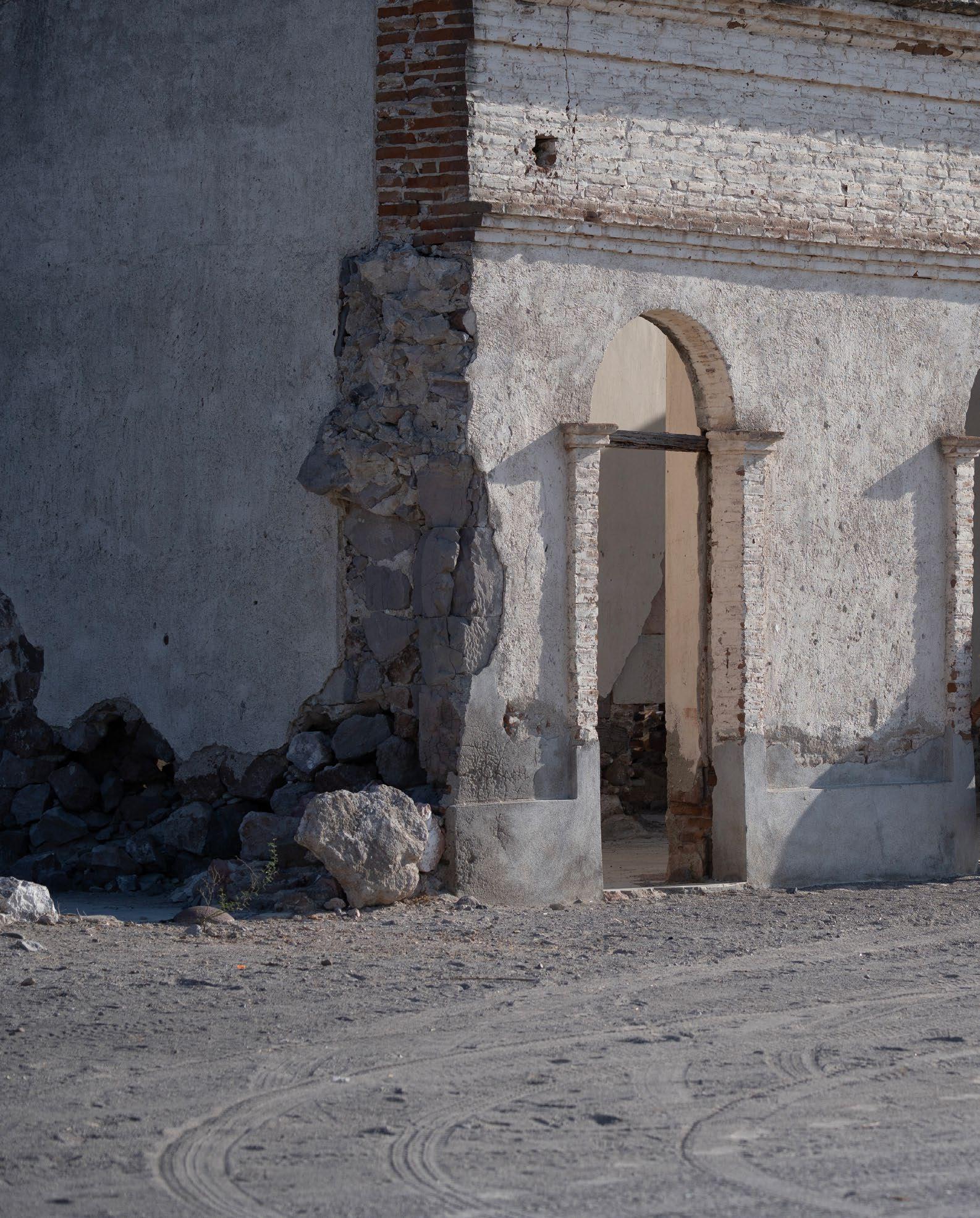
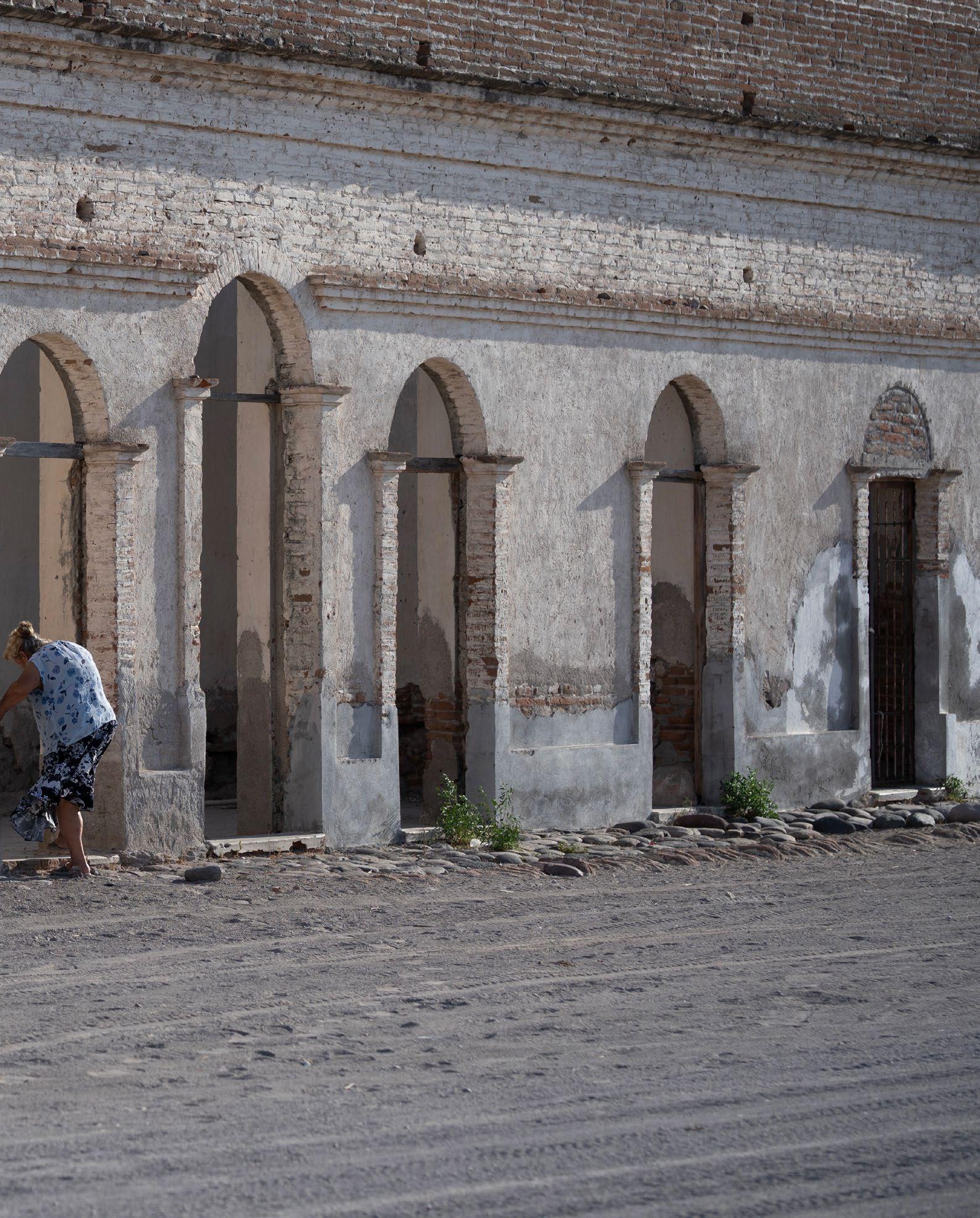
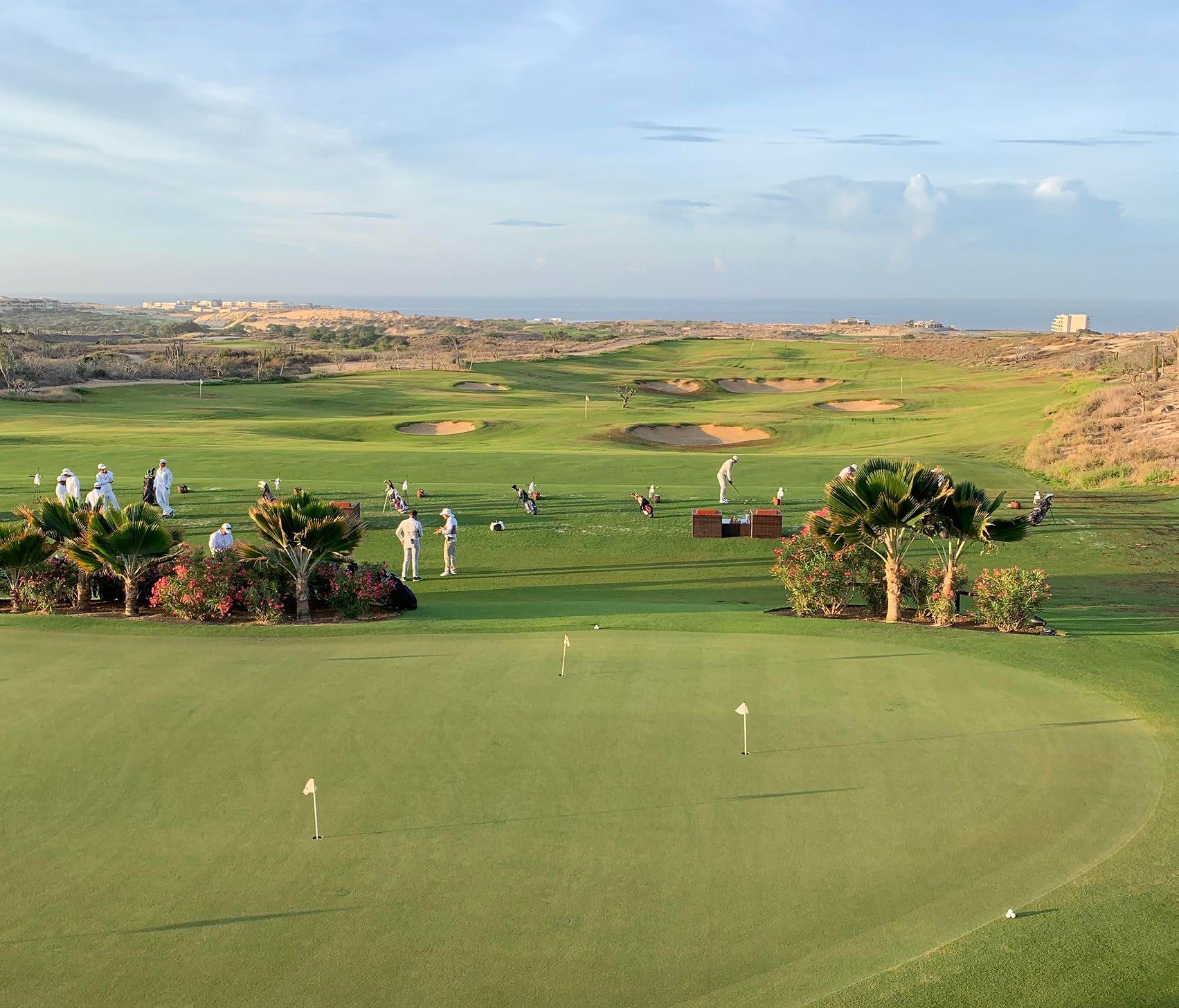
The rise of Los Cabos as a global golf destination didn't happen overnight. It was a process involving one course, one developer, and one real estate milestone at a time. In November 2025, that arc reaches a new milestone: the World Wide Technology Championship returns to Diamante's El Cardonal course. It's the latest inflection point in a story that's been building quietly for decades and now commands global attention.
From Modest Beginnings to a Master-Planned Movement
The roots of golf in Los Cabos stretch back to 1987, when the Mexican government built a modest nine-hole course in San Jose del Cabo, now part of Vidanta. But, as journalist Chris Sands documents, the region's transformation into a true golf destination began in the early 1990s, when developer Don Koll partnered with Jack Nicklaus to create Palmilla Golf Club.
Their vision was to combine world-class design with oceanfront real estate. It set the template. By the mid-1990s and early 2000s, architectural talent like Robert Trent Jones Jr., Tom Weiskopf, Greg Norman, and Tom Fazio consolidated the model by anchoring private residential developments with iconic course design. A case in point is Cabo del Sol's Ocean Course, first carved in 1994, which would be reimagined as the Cove Club, a private, oceanfront experience.
The momentum didn't stall there. In 2009, Diamante opened Davis Love III's celebrated Dunes Course. Soon after, Tiger Woods' El Cardonal debuted in 2014 with the Oasis Short Course following in 2016, reinforcing Diamante's stature as golf real estate's modern flagship.
Forward momentum persists: Querencia is now building a second Tom Fazio course with a planned debut in 2026. Across three decades, Los Cabos has emerged as the most concentrated cluster of signature-designed golf communities in Latin America.
Diamante's Rise: From Dunes to Global Stage
If Palmilla helped launch Cabo's golf-real estate story, Diamante now stands as its most ambitious chapter. After the inauguration of Dunes, El Cardonal, and the Oasis Short Course, the community's evolution continued with the introduction of the Legacy Club, a highly exclusive, invitation-only golf enclave led by Woods again. Featuring dramatic landscaping, a lush, park-like environment, and capped at just 250 members, it promises to redefine golf living in Cabo with a targeted opening by late 2026.
The PGA Effect: A Tournament with Long-Term Signals
From November 3–9, 2025, the eyes of the golf world turn to Diamante. The WWT Championship, now in its 19th year and hosted at El Cardonal since 2023, brings 120 PGA Tour professionals back to the course for four days of stroke play, broadcast live in over 200 countries.
More than a tournament, it's a signal that Los Cabos, and Diamante in particular, have arrived on golf's global stage. Since moving from Mayakoba in 2023, the event has made Diamante its home in Cabo. This shift reflects both course quality and destination prestige.
What makes the event distinctive is how seamlessly it blends elite sport with Baja's lifestyle appeal. Guests and residents will experience more than competition: live music, VIP hospitality, culinary showcases, and fitness events animate the week. "Tacos on 17 by La Lupita" has become the place to see and be seen. At the same time, "Golf is Gourmet" brings pros and chefs together for intimate dinners in private villas.
The event also leaves a mark beyond the fairways. With over USD 3.5 million raised for Mexican charities since its inception, and a strong local volunteer base, the WWT Championship reinforces that Los Cabos is not only a world-class destination, but a community with staying power. At Diamante, philanthropy, design, and global visibility converge in a way few other developments can match.
For real estate buyers, investors, and developers, the presence of a PGA Tour event is strategic. It validates the region's infrastructure, showcases its hospitality capacity, and elevates the brand value of owning property in a place that meets global standards.
Diamante benefits directly, of course. The tournament draws international attention to its courses, villas, and amenities. But the effect radiates across the region. Cabo is no longer just a luxury destination: it's a market with global visibility, recurring media exposure, and a maturing base of high-networth homeowners.
In a world where second-home markets compete for attention, credibility matters. The WWT Championship does what no ad campaign can: it embeds Los Cabos into the global imagination of golf, luxury, and longterm real estate value. For those building, selling, or buying here, the signal is clear. Los Cabos is playing in a new league.






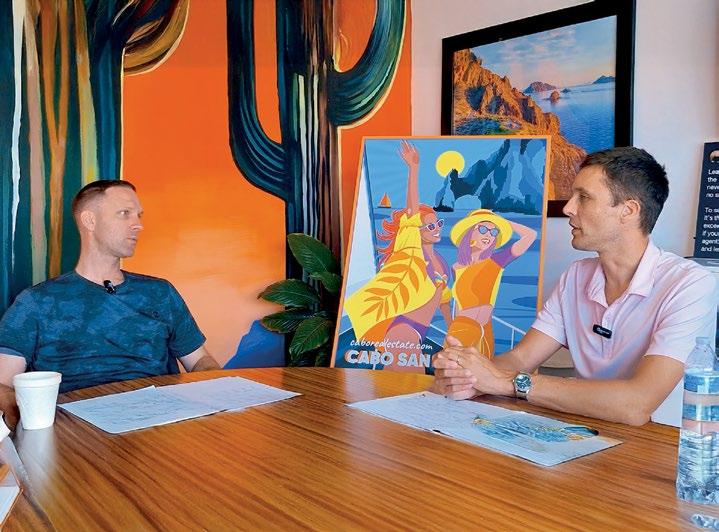

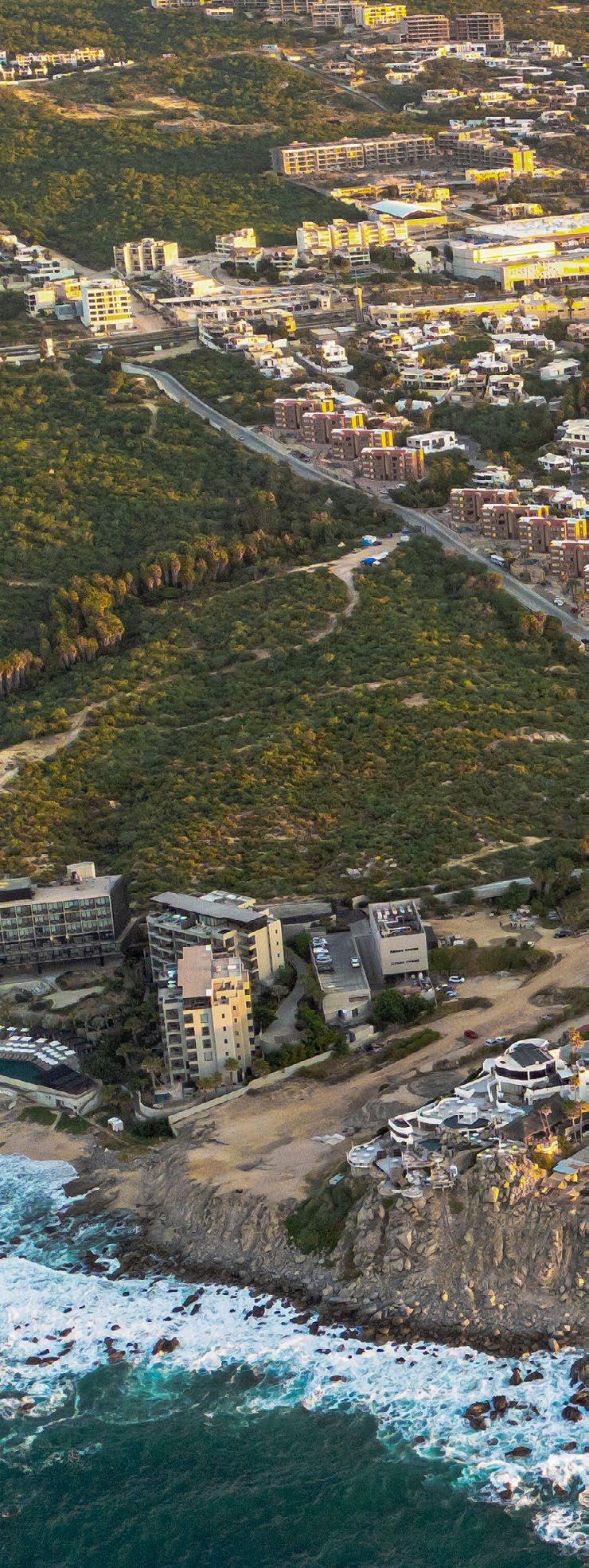
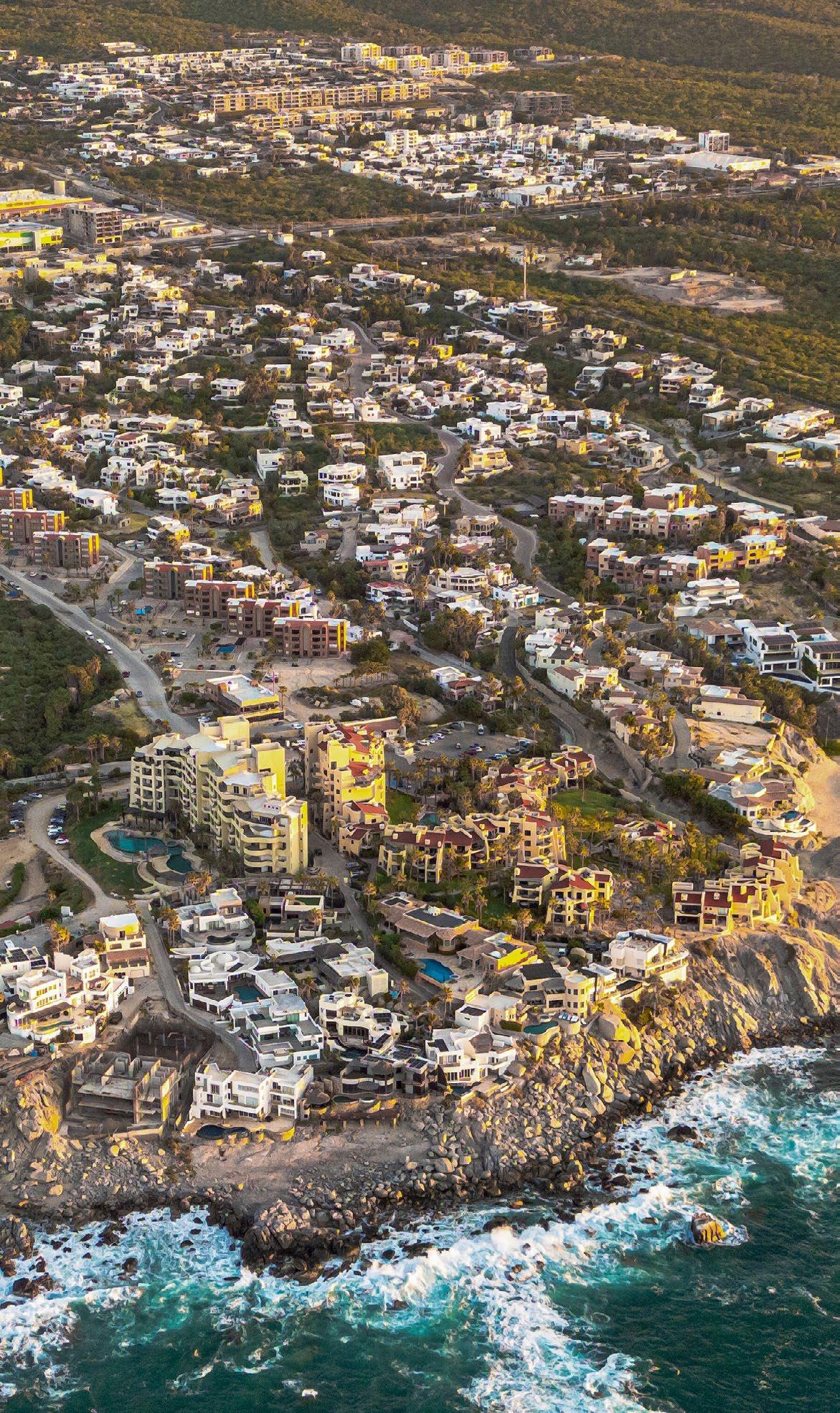
Few places illustrate contrasts as sharply as Los Cabos, where private jets and luxury resorts exist alongside working-class neighborhoods with uneven access to essential services. This contrast defines the region, but so does something less visible: a quiet but significant shift in how its social fabric is being held together.
Across the tourist areas and gated residential enclaves, private wealth and local leadership are converging to build long-term community infrastructure. These are not fleeting acts of charity but structured efforts to address persistent gaps in public services. From blood banks to rehabilitation centers, a cross-cultural, cross-sector model is taking shape. One that acknowledges inequality without pretending to solve it overnight.
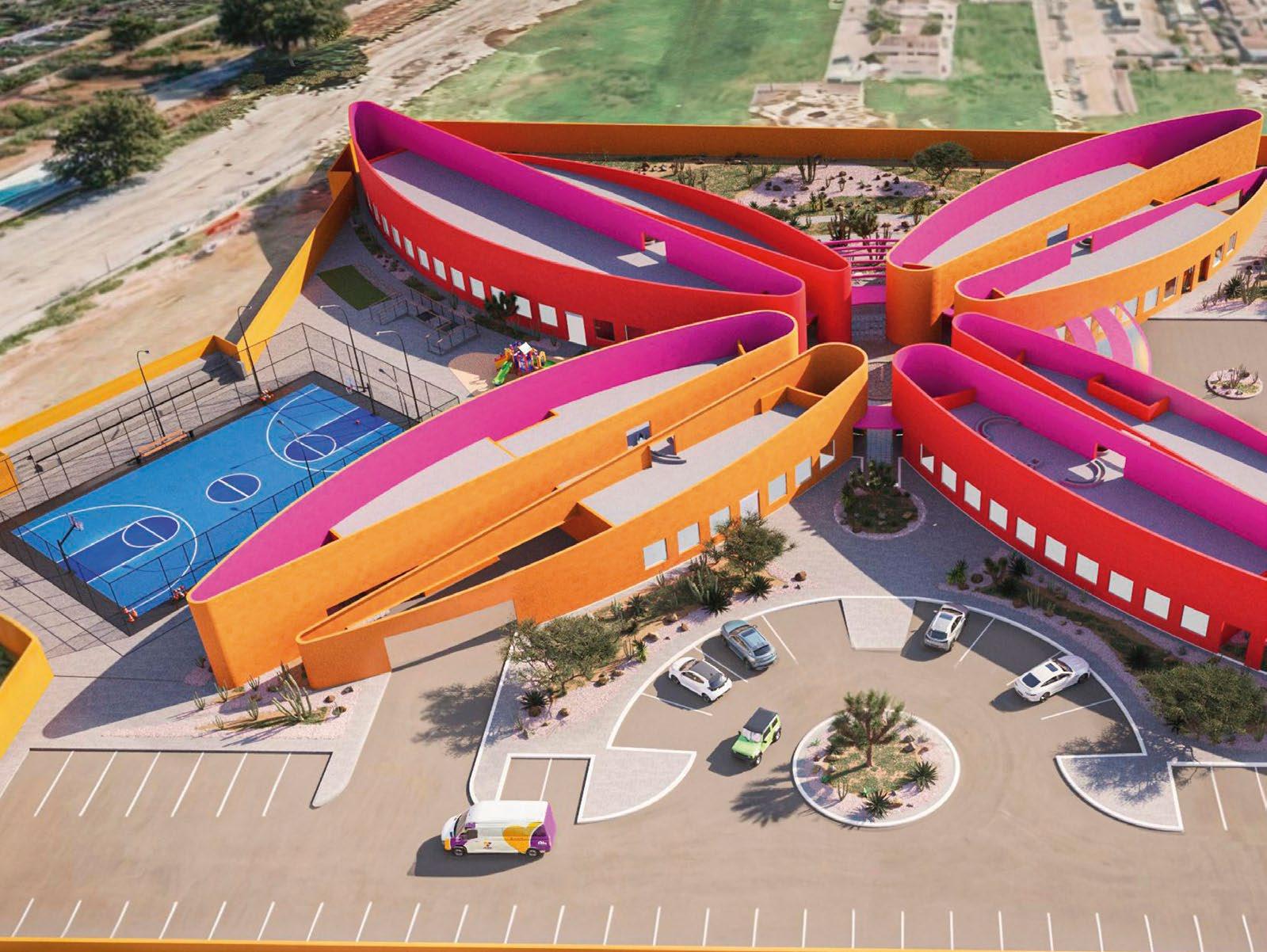
The Service Gap Behind Cabo's Rapid Rise
Los Cabos has experienced vertiginous growth, driven by tourism, real estate, and an influx of internal migration. But while development has brought economic opportunity, more so than in many areas of mainland Mexico, basic services, especially in healthcare, have lagged behind. Until recently, the region lacked a local blood bank, specialized rehabilitation services for children, and reliable transportation for families needing medical care. Even middleincome households often faced long travel times and out-of-pocket expenses to access care in La Paz.
These gaps are not unique to Los Cabos. Still, they are more visible here, where
extreme wealth and modest communities coexist in close proximity. For many families arriving from certain inland regions, Cabo represents an improvement in living standards. Yet the mismatch between private development and public infrastructure has created strain.
In this context, a new kind of collaboration has emerged. The Los Cabos Community Alliance, a collective of foundations, luxury developments, nonprofits, and businesses, leverages its resources and expertise to address specific service gaps in the community. It is not a substitute for government, but a practical response to an urgent need. Rather than short-term aid, these efforts focus on building durable, communitywide systems that can function at scale.
Cabos
Access to emergency blood transfusions in Los Cabos has long been uncertain. While some hospitals do offer transfusions, they typically operate as internal-use facilities and require patients to bring their own donors. The region lacks a true community blood bank — an independent center that collects, stores, and distributes blood to meet broader public needs. In urgent situations, from car accidents to complex surgeries, patients are often referred to La Paz, more than two hours away, where, even then, supply is not guaranteed.
This gap became a rallying point for the Los Cabos Community Alliance. "It's crazy when you think about it," says Korey Riggs, director
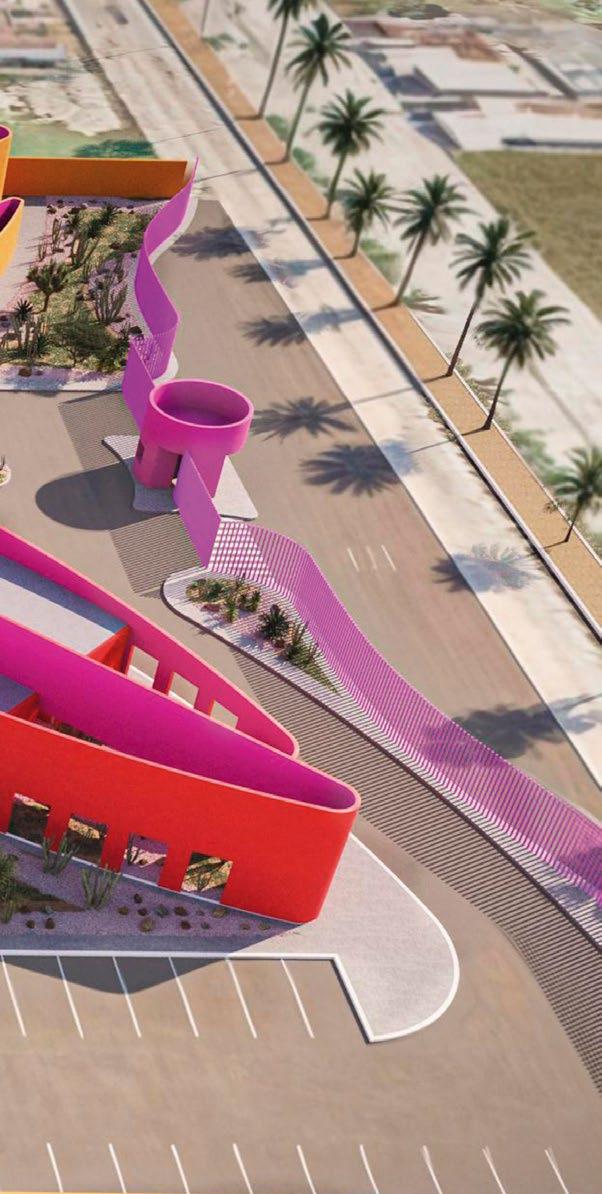
of El Dorado Foundation and Chileno Bay Foundation, and a leading figure within the Alliance. "You have one of the most developed tourist destinations in Mexico, but the nearest reliable blood supply is hours away."
This is not Cabo's first attempt at establishing a blood bank. An earlier effort, which operated from 2008 to 2012, ultimately failed due to operational challenges and a lack of cohesive support. This time, however, the approach is broader and more sustainable. Multiple foundations, including those led by Korey, as well as others such as Cabo del Sol’s Heart and Sol Foundation, along with local partners like Amigos de los Niños, have committed to funding the Blood Bank project and several years of its operations.
The strategy goes beyond bricks and mortar. The blood bank is being designed as a shared community resource: accessible to everyone, whether a visiting tourist, a private resident, or a family living in the local barrios. "In a medical emergency, these divisions disappear," Korey says. "Everyone needs care, and everyone deserves access."
The CRIT: How a Privately Funded Children's Rehabilitation Center Changes Local Healthcare
If the blood bank addresses emergency needs, the CRIT Los Cabos tackles something equally vital but often overlooked: long-term, specialized care for children with disabilities. Until recently, families needing rehabilitation services had little choice but to travel to La Paz or beyond. These are expensive, time-consuming trips that strain already stretched household budgets.
The CRIT (short for Centro de Rehabilitacion e Inclusion Infantil Teleton) marks a turning point. Developed under the umbrella of the Los Cabos Community Alliance and in partnership with Teleton Foundation, this is the first CRIT in Mexico funded entirely by private donors. Construction costs were covered through USD 9.5 million in donations, with an additional USD 5 million secured to fund operations for five years.
"Buildings are not that hard to fund," says Korey. "The challenge is running the project well over a long period." The CRIT model addresses that challenge head-on by incorporating operational funding from the start, an approach that delivers both immediate impact and long-term stability.
More than a single facility, the CRIT anchors what supporters see as a broader children's medical campus. Plans include services like autism care and outpatient clinics. Just as significantly, the CRIT reduces hidden costs for families: fewer lost workdays, lower travel expenses, and more time together, rather than on the road chasing care.
The CRIT reflects a more profound shift in philanthropic focus: not quick fixes, but
foundational services that improve quality of life across the community.
The Network of Community Initiatives Filling Daily Gaps
The blood bank and CRIT stand out for their scale. Still, they're part of a wider network of projects quietly reshaping Los Cabos' social infrastructure.
A community transportation program offers free shuttle services for families traveling to La Paz for treatment, with two specially outfitted buses designed for comfort and dignity. Other initiatives tackle day-to-day challenges: a spay-and-neuter clinic reduces stray populations while providing therapeutic roles for children, and food security programs ensure that vulnerable families have support during economic downturns.
Together, these projects form a networked strategy for community resilience. They aren't charity. They are essential services that help Los Cabos function more cohesively in the face of rapid development.
How Cabo's Diverse Community Is Rewriting the Rules of Philanthropy
At the heart of this system is a cross-cultural model that reflects the unique social fabric of Los Cabos. Cooperation doesn't follow a simple donor-beneficiary line. It stretches across layers: private developments fund local schools, international donors partner with grassroots organizers, and tourists participate in programs meant initially for residents.
This works in significant part because of people at the helm of these foundations who move between worlds, connecting American, Canadian, and Mexican cultural expectations, and translating donor enthusiasm into locally effective solutions. "You can't just import fixes," Korey notes. "You have to understand what works here and build around it."
Equally critical is a pragmatic approach. These projects are driven by necessity, not ideology. In a region where public services lag, private stakeholders have a direct interest in
Our lifestyle guru Barrie Livingstone highlights fun images taken in and about town. From fun design to fabulous property. Barrie is always “on the pulse”. Enjoy looking at Cabo life through his creative design eye



Let me introduce you to one of my ali-time favorite flowering Tabachín. depending on the region-but globally, it's known as the Royal Poinciana With its dazzling bright orange-to-crimson blooms and lush. fern-tike fotiage. it's a showstopper in any Cabo garden. And the best part? lt's low-maintenance-just regular watering, no fertilizer required.
lf you're ever behind La Comer at the Glorieta San José, make sure to stop by and admire the rare crimson variety-exactly where this photo was taken. Nature at its most vibrant!

Craving mouthwatering, authentic Mexico City cuisine made fresh daily with a vibrant variety of options? Look no further than Señora Cocina, nestled in the heart of Palmilla Shoppes. With joyful staff, glorious flavors, and prices that won't break the bank, it's the perfect neighborhood spot where everyone feels welcome. Many of you witl recognize the charismatic owner Juan Pablo from Arbol@ Las Ventanas and if you don't you will by the time your meal is over, he will make you feel very welcomed. Come hungry-leave happy!
Life flows a Uttle differently down here in Cabo-and if you haven't experienced it from the seat of an ATV, you're missing out. Whether you rent one for a morning spin or a full-day adventure, it's the perfect way to get your groove on and explore the rugged beauty of the East Cape or cruise out to laid-back Pescadero.
Pro tips; pack plenty of water, towels, hats, sunscreen, and don't forget to sync your Bluetooth with your favorite tunes. Ride smart, soak up the vibes, and get ready for a wild, unforgettable ride.

By Barrie Livingstone Contact:
strengthening the broader community. Projects like CRIT and the blood bank serve everyone, making Los Cabos a livable, investable destination for residents and visitors alike.
What Cabo's Experiment in Private-Public Cooperation Reveals
Los Cabos is often viewed through the lens of disparities. Luxury versus hardship, foreign wealth alongside local struggle. Yet beneath these contrasts lies a more complex reality: a civic infrastructure taking shape, quietly built through cooperation and shared interest.
What makes Los Cabos notable is not the existence of inequality but the emergence of practical cross-sector investment in core community services. This is philanthropy as maintenance of a functioning society in a region where public infrastructure hasn't kept up with private growth.
In doing so, Los Cabos offers a rare example of how fractured communities can begin to stitch themselves together, not by erasing difference, but by working productively across it.
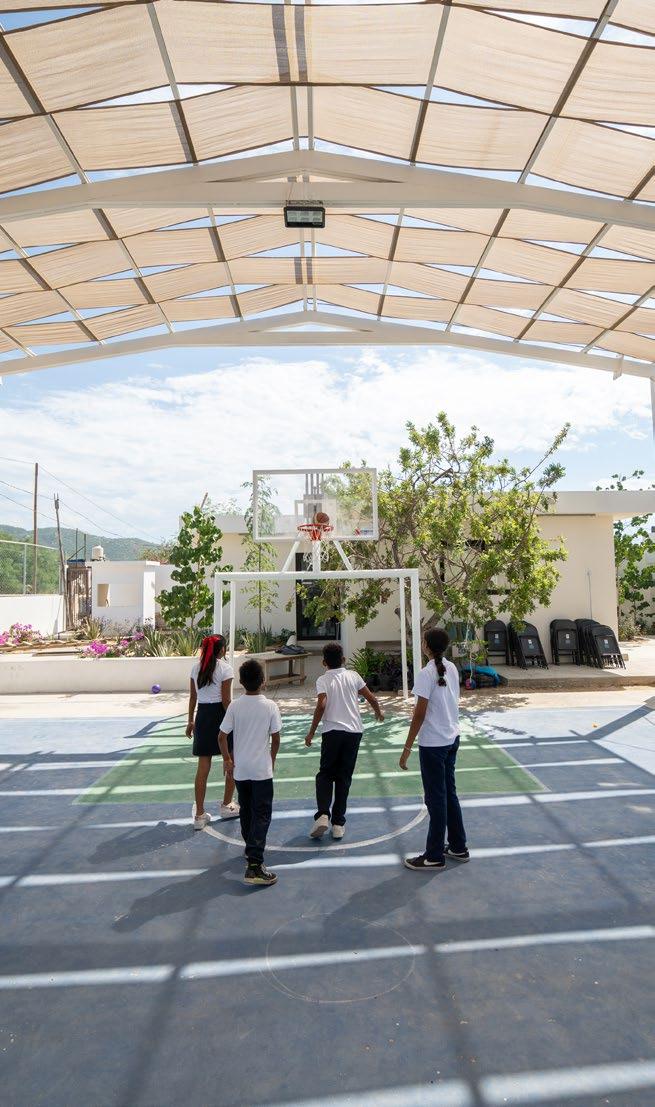
"You have one of the most developed tourist destinations in Mexico, but the nearest reliable blood supply is hours away."
Luxury, once shorthand for status and material overabundance, is being redefined. In an age of longer lifespans, extended careers, and rising health awareness, the idea of what it means to "live well" has shifted.Ocean views and golf memberships still matter, but increasingly, so does the promise of physical vitality at 75, mobility at 85, and cognitive clarity into one's 90s.
This recalibration is visible not only in lifestyle choices but in hard assets, especially real estate. Today's premium buyers aren't just investing in homes; they're investing in environments designed to sustain their energy, their bodies, and their autonomy. That shift is being felt acutely in Los Cabos, where high-end communities are integrating wellness and medical infrastructure into their core value proposition.
One clear example is COLEL, a regenerative medicine and longevity clinic slated to open in early 2026 within Palmilla, one of Cabo's most established luxury communities. Unlike a spa or wellness retreat, COLEL will offer personalized protocols that combine diagnostics, stem cell therapies, and targeted interventions for conditions like chronic pain, inflammation, or metabolic imbalance.
Its presence raises a striking question: What does it mean when cutting-edge medicine becomes part of the real estate offering? To answer that, we need to understand the deeper trend, which goes beyond Los Cabos and south Baja, but is taking root here with particular force.
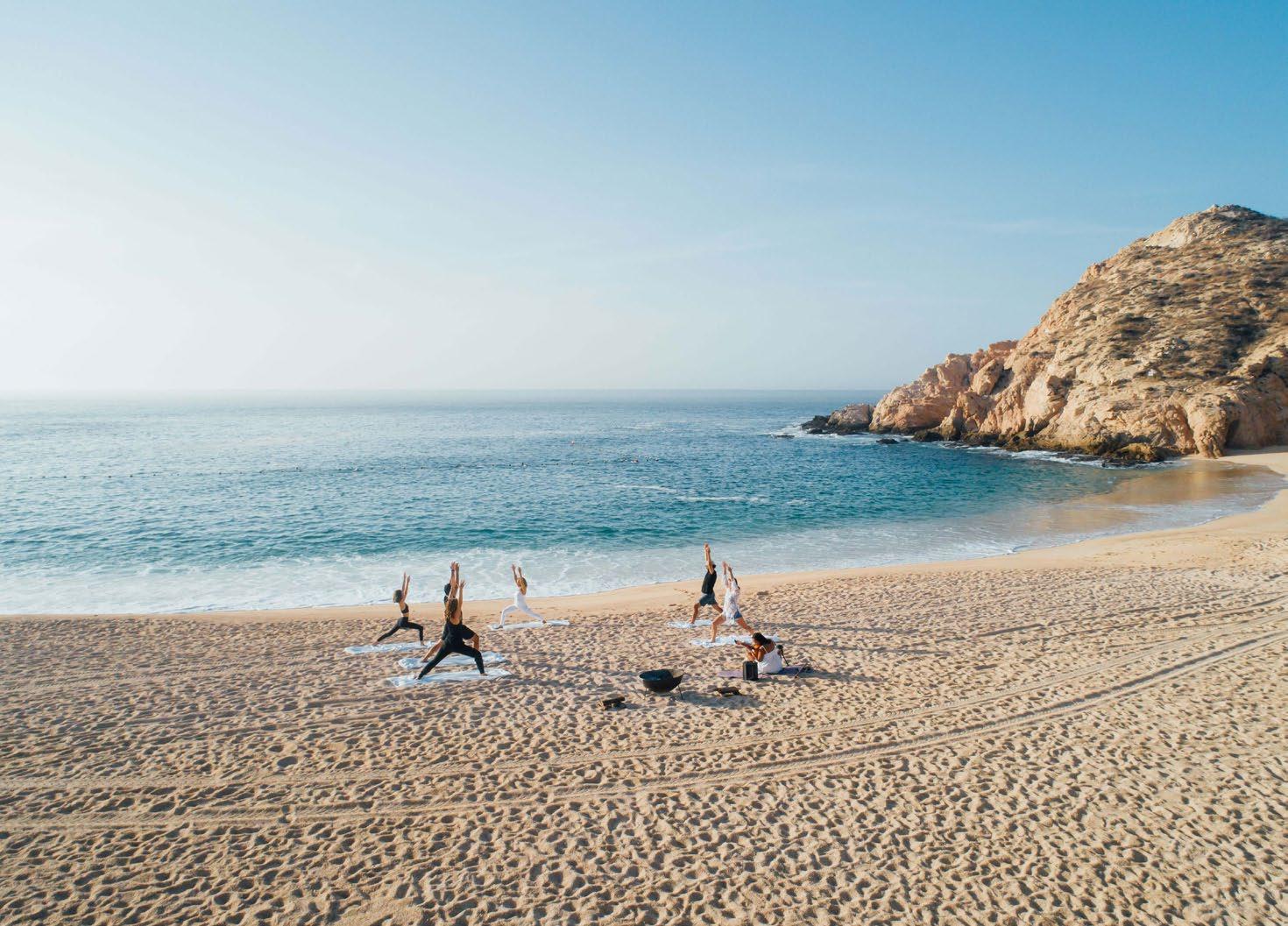
visitloscabos.travel
For decades, health care has been reactive: treat the disease once it shows up. Regenerative medicine flips that script. It asks: What if we could repair tissue before it breaks down? What if aging itself, once accepted as inevitable, could be slowed, interrupted, or even reversed?
Those questions are no longer hypothetical. The global regenerative medicine market is expected to grow tenfold by 2032, driven by innovations in stem cell therapy, gene editing, and tissue engineering. What began in academic labs has now entered the commercial sphere, often through elite clinics catering to an affluent, health-optimizing clientele.
COLEL belongs to this new category. It's not a hospital, nor a spa. It's something in between: a facility where clients undergo personalized diagnostics and receive targeted interventions for aging-related concerns, from knee pain and inflammation to hormone imbalances and early-stage metabolic disorders.
Some come for skin rejuvenation, others for systemic protocols designed to extend healthspan. Every treatment plan is customized. Stem cells are produced on-site. The protocols blend clinical rigor with a hospitality experience designed to feel like a sanctuary, not a surgery.
As Dr. Jonathan Hernandez, COLEL's chief scientific officer, explains: "We don't just offer facials and massages. We manufacture our own mesenchymal stem cells. We build treatments from the inside out." He's quick to note that luxury, in this context, isn't about marble floors or valet service — though those exist. It's about waking up pain-free and feeling vital.
This approach might sound rarefied, even futuristic. But it's gaining traction fast. Clinics from Switzerland to Costa Rica now offer high-end regenerative programs. And the once firm line between medicine and lifestyle is starting to dissolve.
Real Estate Reimagined
Wellness infrastructure is no longer a niceto-have in luxury real estate. It's increasingly the core offering. Developers once competed
on golf access or beachfront exposure; now, they're integrating cryotherapy chambers, IV lounges, and personalized health labs into the residential fabric.
Global numbers support the transition. Wellness real estate is growing faster than any other segment of the USD 6+ trillion wellness economy. In 2023 alone, the sector reached USD 438 billion, more than doubling in size in just four years.
Buyers are paying attention. Properties that promise healthier living environments, like filtered air, biophilic design, or access to diagnostics, can command premiums of 10 to 25 percent.
Palmilla is no stranger to premium living. But the arrival of COLEL marks a turning point: it's one of the first times a master-planned community in Baja California Sur has made regenerative medicine part of its everyday lifestyle offering. A resident might now walk from their villa to a consultation on stem cell therapy. Healthspan becomes part of home value.
The messaging is clear: your home should be a place that not only holds value, but sustains you. Still, the line between enhancement and necessity remains blurry. For some, these additions are status symbols. For others, they're part of a more profound change, where aging well is the new horizon of what it means to live well.
Los Cabos has long drawn those in search of escape: snowbirds, retirees, remote professionals, and travelers looking to unplug. But its role is evolving. Increasingly, it's not just a place to visit but a place to recover, to reset, and to optimize.
The region now hosts a growing number of part-time and full-time residents who want long-term vitality in addition to sand and sun. The setting helps. With its proximity to major U.S. cities, its natural beauty, and its upscale infrastructure, Los Cabos is positioned to attract a particular kind of global citizen: one who is aging, affluent, and looking to age well.
The opening of COLEL at Palmilla fits squarely into that pattern. But it's not an isolated case. In Loreto (six hours north, but within the same state) a new wellness

resort called Mailena is set to debut in 2026. It will include a dedicated longevity center, biohacking suites, and personalized health programming for travelers and residents alike. That a project of this kind is happening in Loreto, not just Los Cabos, signals something deeper: Baja California Sur isn't just riding the wellness wave; it is also shaping it.
There's something undeniably compelling about a home that helps you live longer. But there's also something worth pausing over.
When medical-grade treatments are offered in resort communities, who decides where health ends and luxury begins? At what point does longevity become just another asset, something to be optimized, upgraded, even flaunted? And what does it mean when healthcare is packaged as a lifestyle amenity, accessible only to those who can afford a second home?

COLEL doesn't hide its ambition. Nor does Mailena. These projects reflect real demand and genuine innovation. For many, they offer meaningful improvements in quality of life, especially for those navigating the second half of it. But their existence also reflects broader inequalities: not everyone can "biohack" their way into a longer, pain-free future.
Still, the emergence of this model, where wellness is a core function of place, marks a shift that's hard to ignore. Healthspan is becoming an organizing principle for how the wealthy choose where to live, how to age, and how to spend. And Los Cabos, already fluent in hospitality and design, finds itself at the edge of that frontier.
The implications go beyond medicine. They touch how we define luxury, how we think about time, and what we expect from the places we call home.
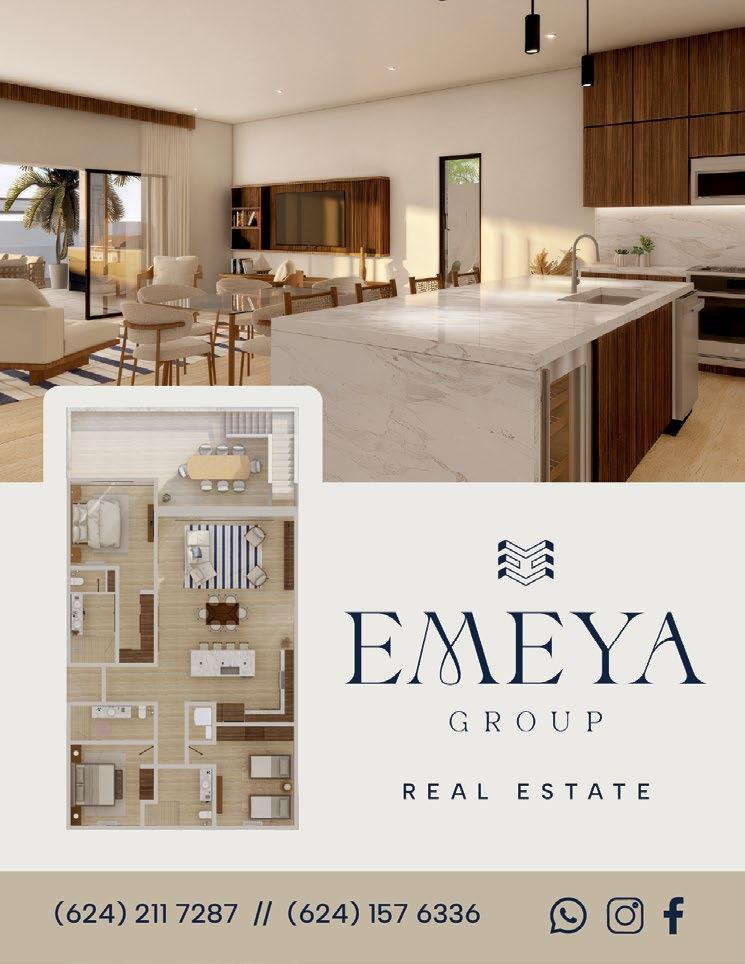
What defines a distinctive property in Baja California Sur today goes beyond square footage to encompass character, setting, and lifestyle access. The region's real estate market is diverse, featuring everything from surf enclaves where new construction is transforming beach towns to golf communities anchored by world-class courses, as well as oceanfront residences along the Corridor.
Among the current offerings is a landmark estate in Diamante, built on a scale rarely seen on the Pacific. In addition, there is a beachfront residence along the Corridor, where direct access to the sand is a defining feature. A home in Club Campestre seamlessly integrates golf with masterplanned living, and new pre-construction projects in Cerritos are attracting buyers who recognize the long-term potential of this rapidly growing community.
Each of these properties reflects the broader trends driving demand in Baja: the quest for space, stunning views, investment potential, and a lifestyle that balances retreat with connectivity. What ties these homes together is not their price point but their distinctiveness, whether that be commanding ocean frontage, integration with a golf course, or the promise of growth in an emerging destination.
The following selection showcases five properties currently on the market, illustrating how buyers are choosing to live in Baja California Sur today.
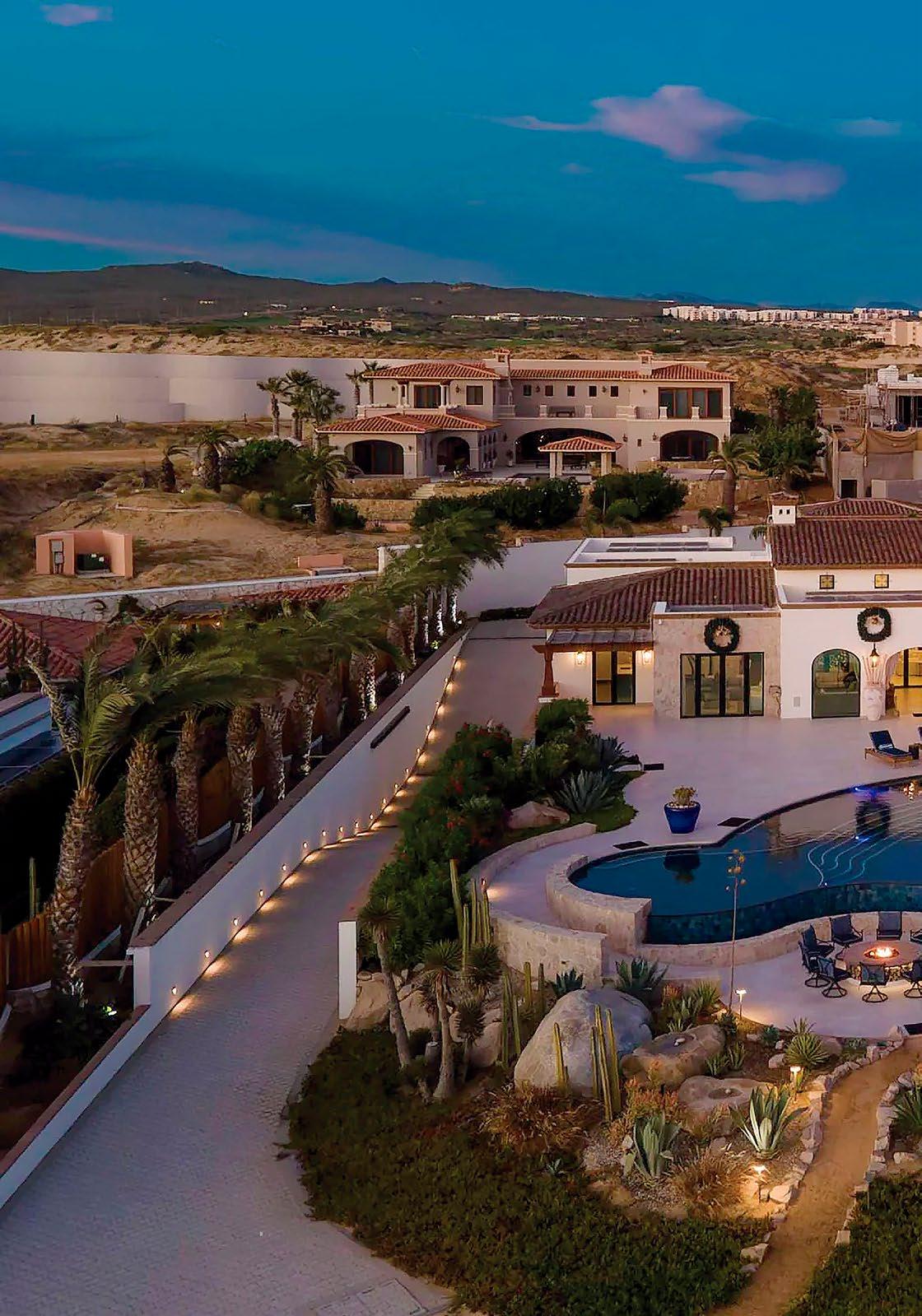
Diamante Cabo San Lucas — Pacific Coast, just 20 minutes north of downtown
Set along the oceanfront within the exclusive Beach Estates at Diamante, Villa Serena is a contemporary masterpiece spanning over 56,000 sq ft in total, with 26,674 sq ft of interiors and more than 30,000 sq ft of outdoor terraces. Designed to balance privacy and grand-scale entertaining, the residence offers eight bedrooms and nine full bathrooms, including a primary suite with its own private pool and terrace. Multiple
guest casitas, expansive living and dining areas, and seamless indoor-outdoor flow showcase uninterrupted ocean vistas. Resort-caliber amenities include a dedicated spa, fitness center, wine cellar, and multiple pools, as well as entertainment lounges and gathering spaces. The property also provides garage parking for up to 12 vehicles, solar-powered infrastructure, and direct access to Diamante’s world-class golf, dining, and lagoon. Villa Serena brings together scale, design, and setting at a level rarely seen on Cabo’s Pacific Coast.
24,995,000 USD
465,826,816 MXN
Property ID: #24-5628
Alen Fabjan alen@ogroupcabo.com +1 480 264 1006
The Oppenheim Group Cabo ogroupcabo.com
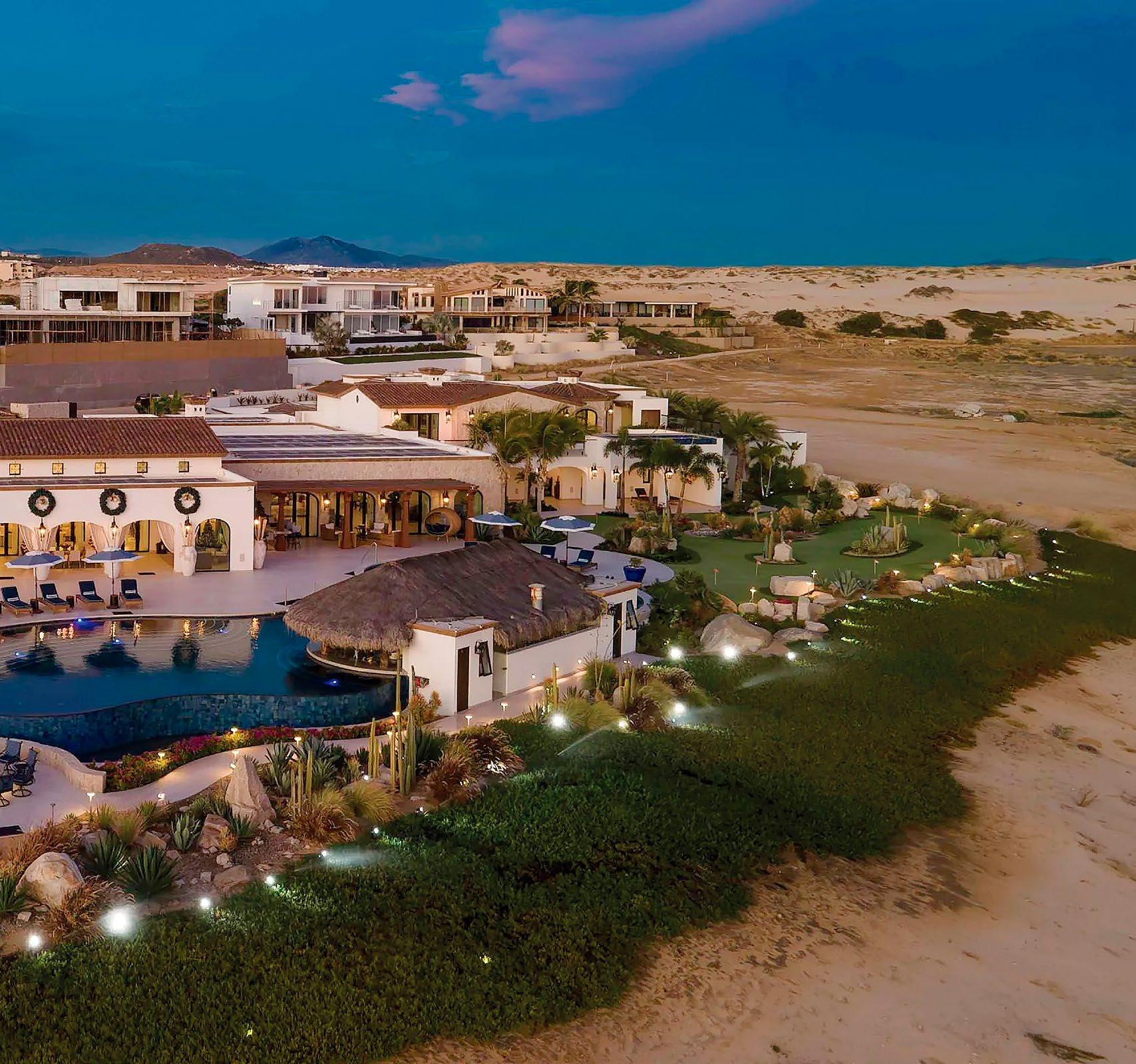
Cerritos Beach, Pacific Coast — 50 minutes north of downtown Cabo San Lucas
Serenity at Cerritos is a new development of 15 residences, each with its own floor and a focus on privacy and proximity to the beach. This pre-construction penthouse offers 3,873 total sq ft, including a singlelevel interior, a spacious terrace, and a private rooftop designed for entertaining or quiet retreat. The threebedroom, three-bathroom layout is finished with quartz countertops, fine carpentry, and a full kitchen. Sliding glass doors open to ocean views, while the rooftop allows for a lounge, and dining area. Optional upgrades include a terrace grill, wine fridge, jacuzzi, and fire pit. Within walking distance of Cerritos Beach, the penthouse balances comfort and access. It is an opportunity to secure a top-floor residence in one of the Pacific Coast’s most active communities.
1,085,000 USD 20,220,928 MXN
Property ID: #25-942
María Ayala / EMEYA Group info@emeyagroup.com
majoayala@emeyagroup.com +52 624 157 6336

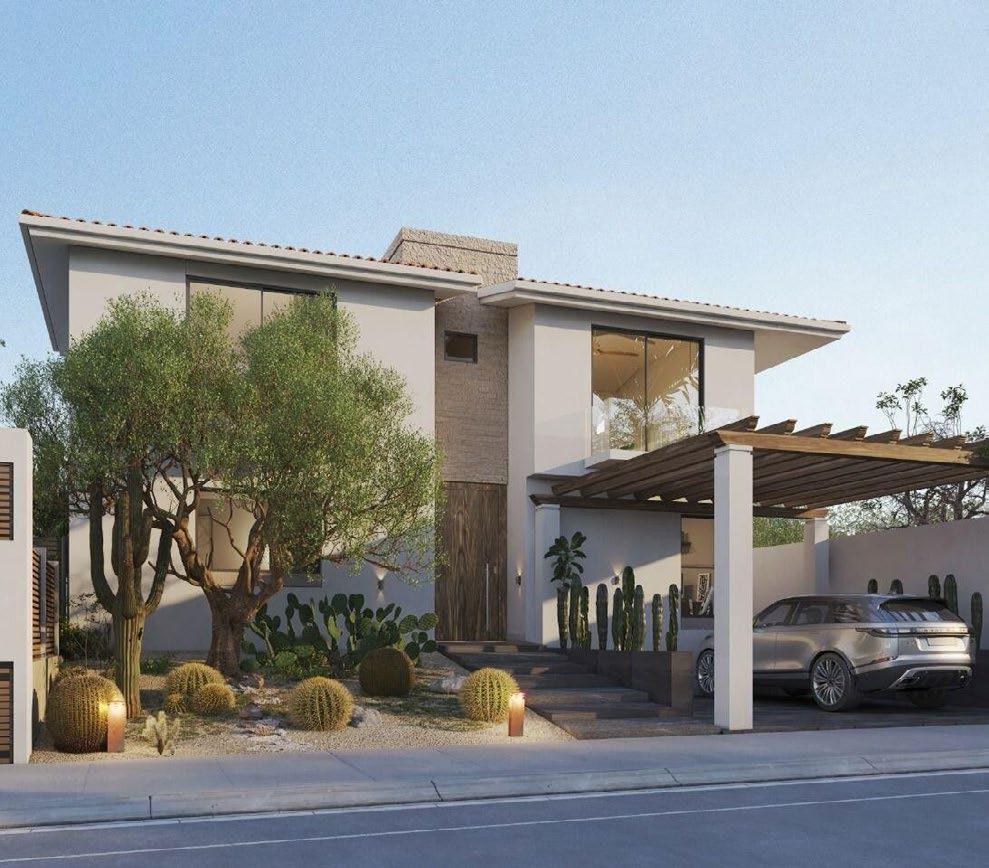
Vista Hermosa 53 is a pre-construction residence in Club Campestre, a gated golf community in San Jose del Cabo known for its Jack Nicklaus Signature course and central location. Planned at 2,431.76 sq ft, the home will feature four bedrooms and three-and-a-half bathrooms. The design emphasizes open living, with floor-to-ceiling glass doors connecting interiors to terraces with a private pool. Contemporary lines blend with Baja-inspired details, creating a residence suited for both full-time living and investment. As part of one of San Jose’s most established communities, future owners will enjoy privacy, security, and access to golf, beach clubs, and local amenities.
1,250,000 USD 24,000,000 MXN
Property ID: #25-3288
marketing@caborealestate.com
+52 624 218 4534
REmexico Real Estate caborealestate.com
Tourist Corridor, Sea of Cortez — between San Jose del Cabo and Cabo San Lucas
Casa Agave is an oceanfront estate that blends Baja heritage with contemporary luxury. Positioned along the corridor, the property offers 65 feet of beachfront and uninterrupted views of the Sea of Cortez. The 5,500 sq ft residence includes five en-suite bedrooms and a detached casita, ideal for hosting family or guests. Open-concept interiors extend to a wide terrace where living and dining areas frame panoramic ocean vistas. With no HOA fees or restrictions, Casa Agave offers unusual freedom for an oceanfront home in this location. A self-contained retreat on one of the most sought-after stretches of shoreline, it balances privacy, character, and direct beach access.
9,495,000 USD 176,956,416 MXN
Property ID: #25-3995
Gabriela DiGiuseppe / The Agency Baja gaby@theagencybaja.com
+1 954 494 8935
Jorge Macías / The Agency Baja jorge@theagencybaja.com
+52 612 104 2063
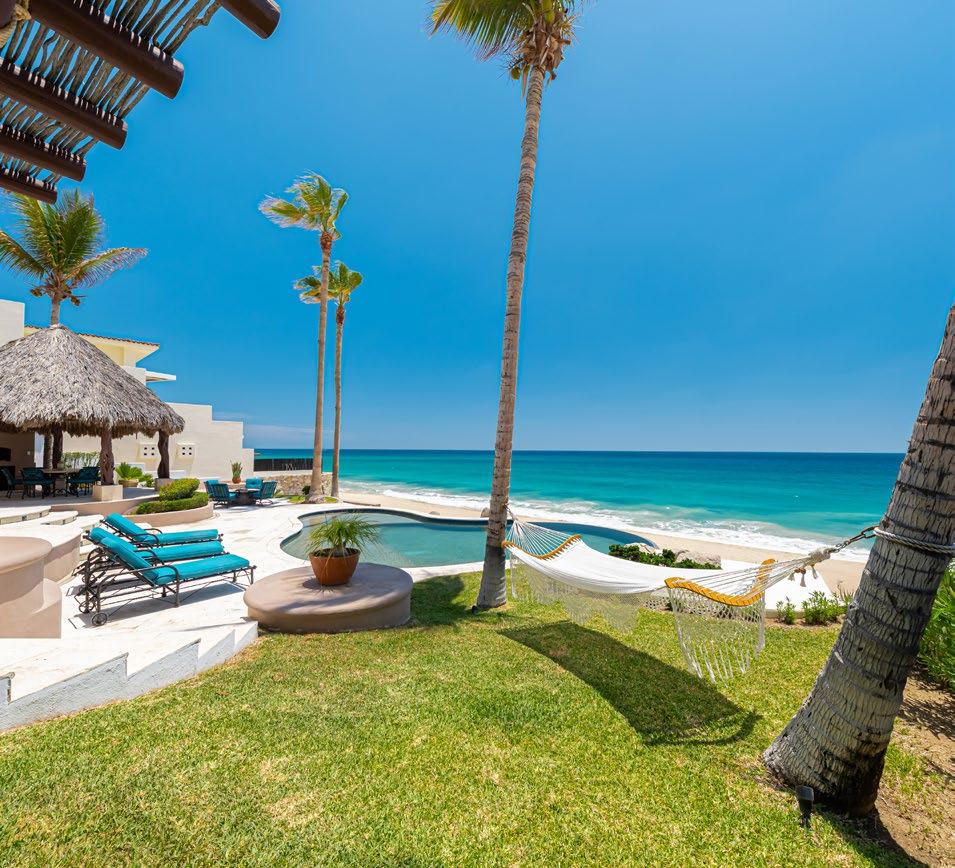

Cerritos Beach, Pacific Coast — 50 minutes north of downtown Cabo San Lucas
Oasis del Mar introduces its flagship model home, a pre-construction residence designed for easy beachside living. Just steps from the surf of Cerritos, the fourbedroom, four-bath home spans 3,604 sq ft, including over 1,000 sq ft of terraces with ocean and mountain views. Interiors are planned with open layouts, natural light, and quality finishes. The kitchen will be equipped with modern appliances and custom cabinetry, while each bedroom features an en-suite bathroom for added privacy. Owners will also have access to community amenities, including a clubhouse, lap pool, hot tub, and landscaped grounds. Set within a new gated community on Cerritos’ only paved road, the home combines convenience, thoughtful design, and proximity to one of the Pacific Coast’s most iconic beaches. Financing and a lease-back option are available.
899,000 USD 16,754,483 MXN
Property ID: #25-2973
Karina Christensen / Ronival Real Estate kchristensen@ronival.com +1 406 600 0432
Tee off in exclusive luxury at Los Cabos' private golf clubs. Experience impeccable fairways, pristine greens, and ersonalized service at prestigious venues known for their exclusivity and world-class amenities.
Cabo del Sol- Cove Club Course 18 holes
El Dorado 18 holes
Querencia 18 holes
Costa Palmas at East Cape 18 holes
Strike the perfect balance between exclusivity and accessibility with Los Cabos' semi-private golf courses. These clubs offer a blend of membership benefits and welcoming guest access, ensuring an unforgettable golfing experience.
Diamante
- El Cardonal Course 18 holes
- The Dunes Course 18 holes
- The Oasis Short Course 12 holes
- Putting Course 18 holes
- Legacy course 18 holes (coming soon)
Quivira Golf Club 18 holes
Delve into the exclusivity of Los Cabos' private/limited resort access golf courses. These hidden gems offer an elite golfing experience with restricted access, allowing you to savor the beauty of the game in a serene, luxurious environment.
Twin Dolphin Golf Club 18 holes
Chileno Bay 18 holes
Explore our complete guide to golf in Los Cabos. The map organizes the region's courses into four clear categories, making it easy to find the setting that matches your game. From elite, championship
experiences to relaxed rounds beneath the Baja sun, this guide offers a straightforward way to navigate one of the world's most distinctive golf destinations.
For golf aficionados seeking affordability and variety, Los Cabos' public courses provide an excellent selection. These courses welcome players of all skill levels, offering a chance to explore the region's natural beauty while enjoying the sport.
Solmar Golf Links 18 holes
Cabo San Lucas Country Club 18 holes
Cabo Real Golf Club 18 holes
Palmilla Golf Club 27 holes
- Mountain 9 holes
- Ocean 9 holes
- Arroyo 9 holes
Club Campestre 18 holes
Cabo Del Sol Course 18 holes
Vidanta Golf Los Cabos 9 holes
Puerto Los Cabos 27 holes




